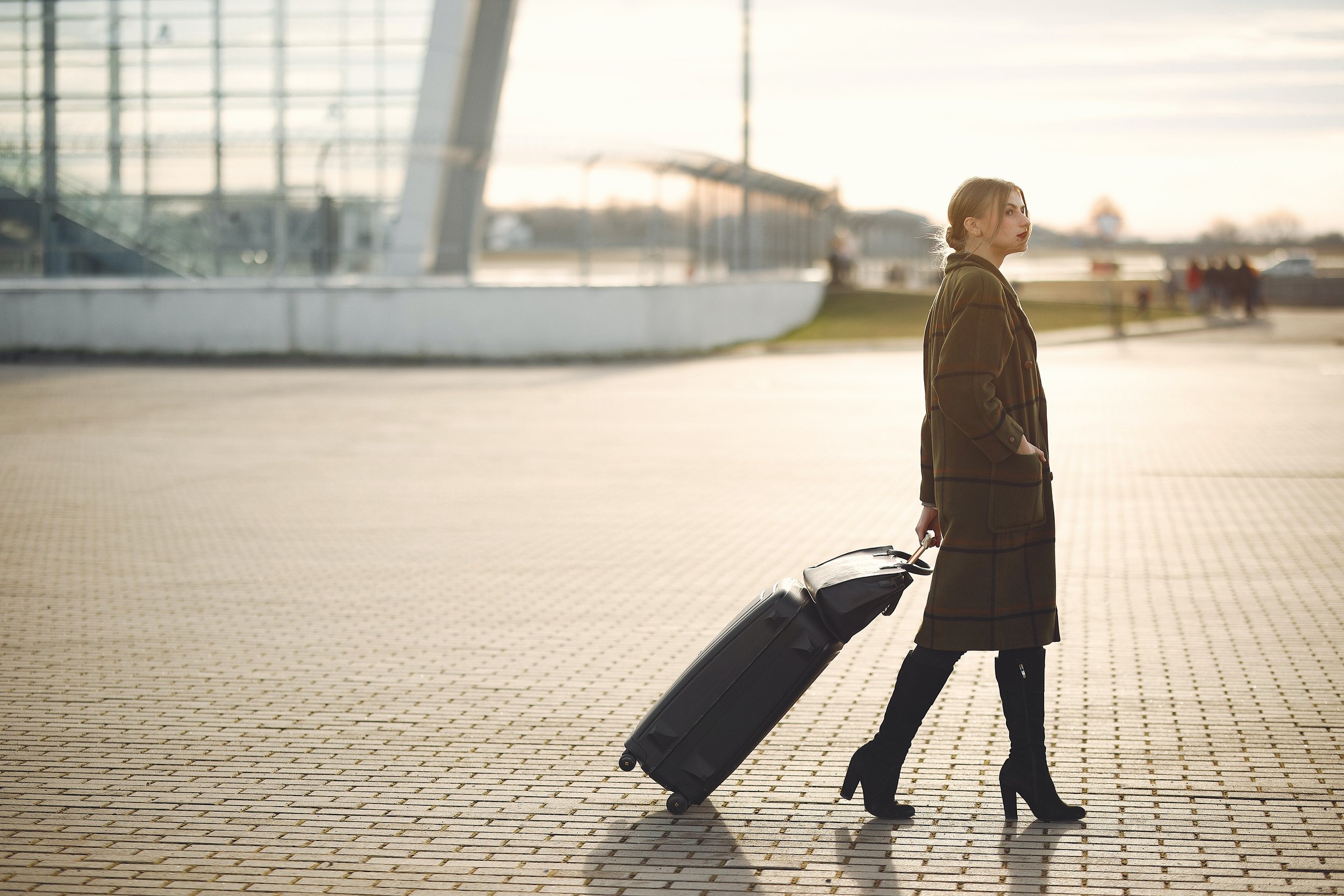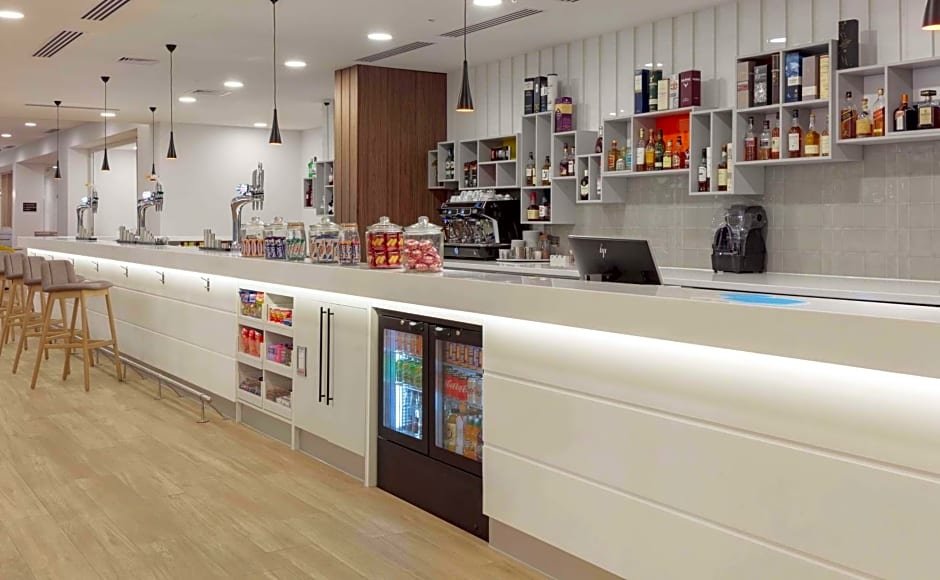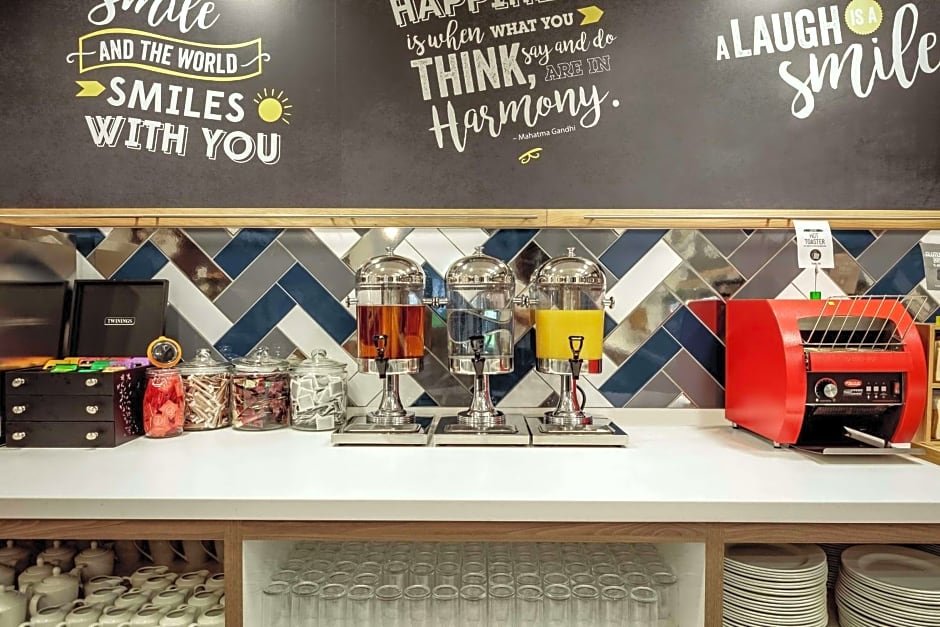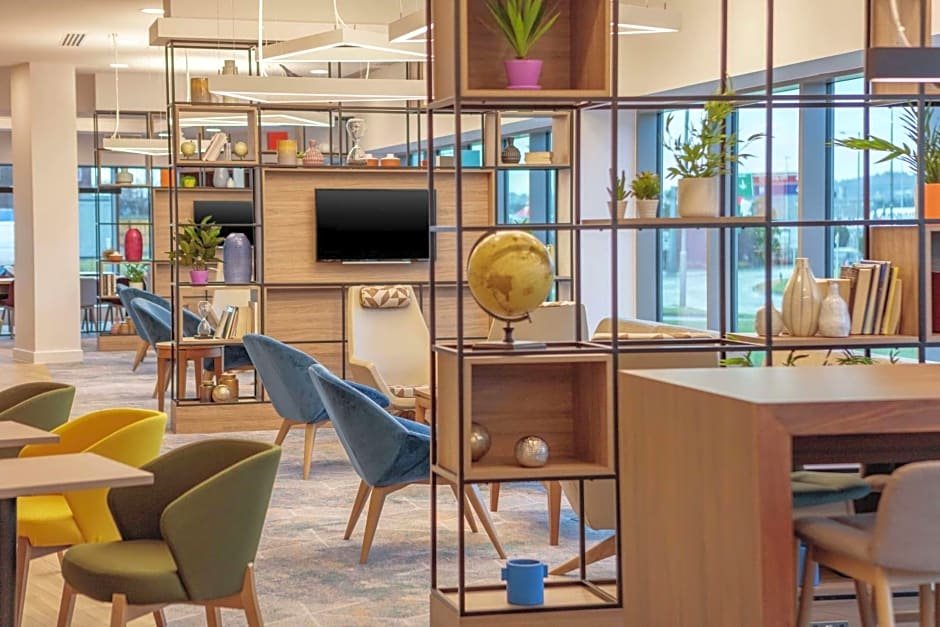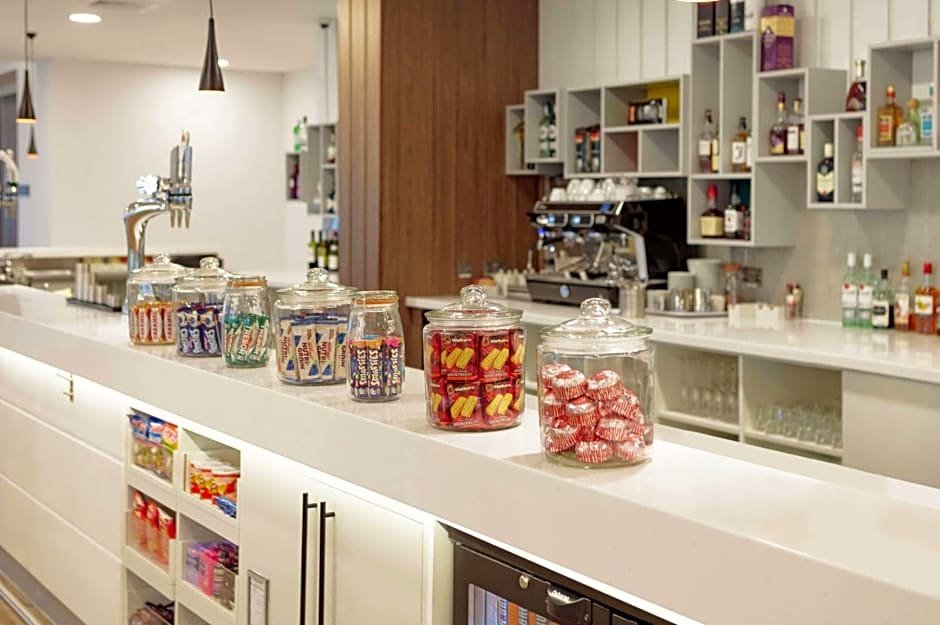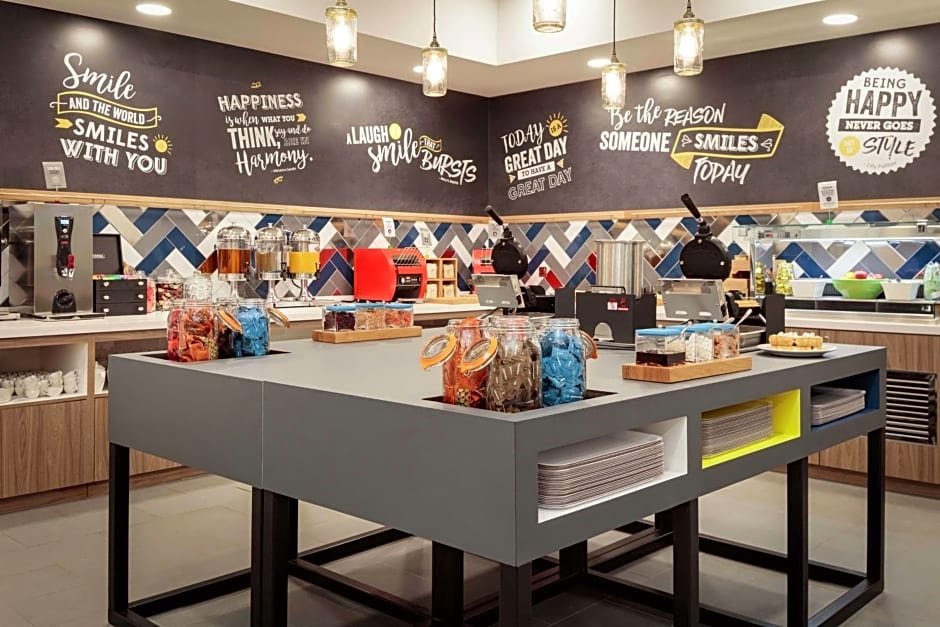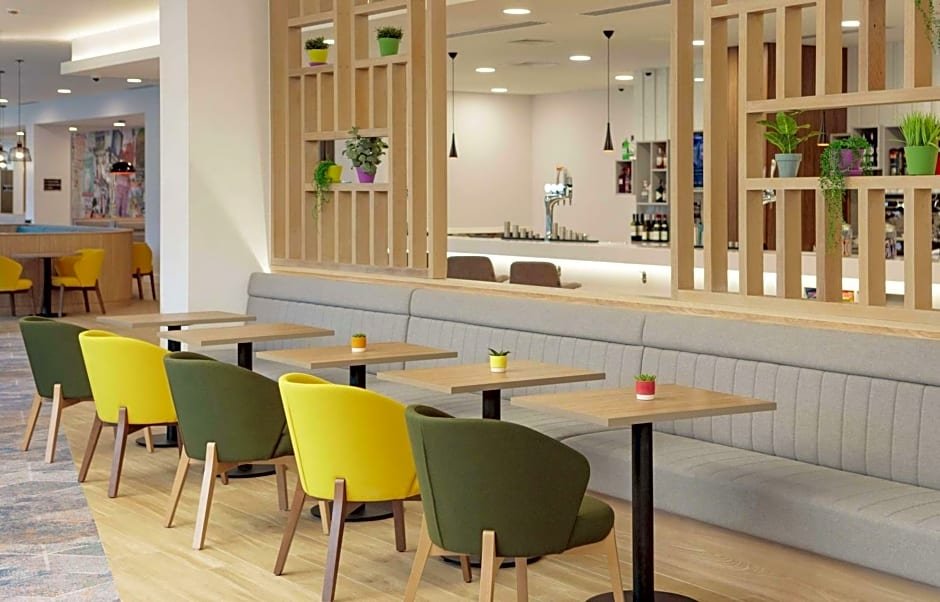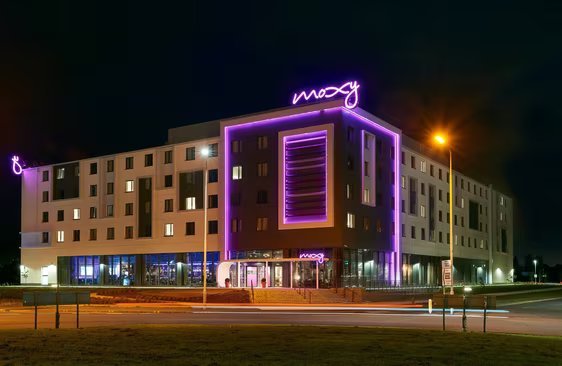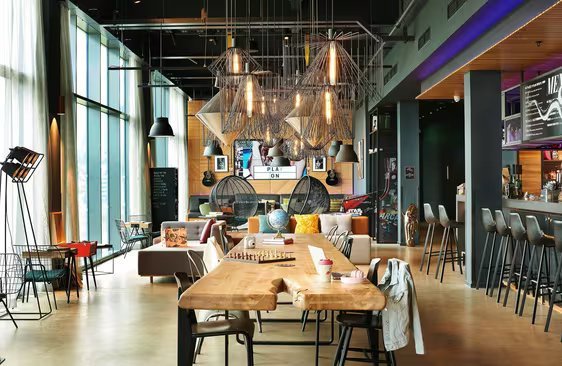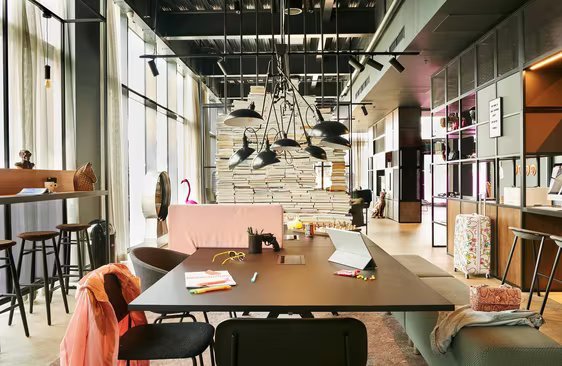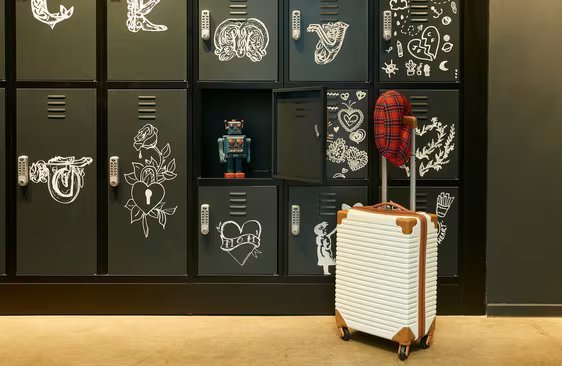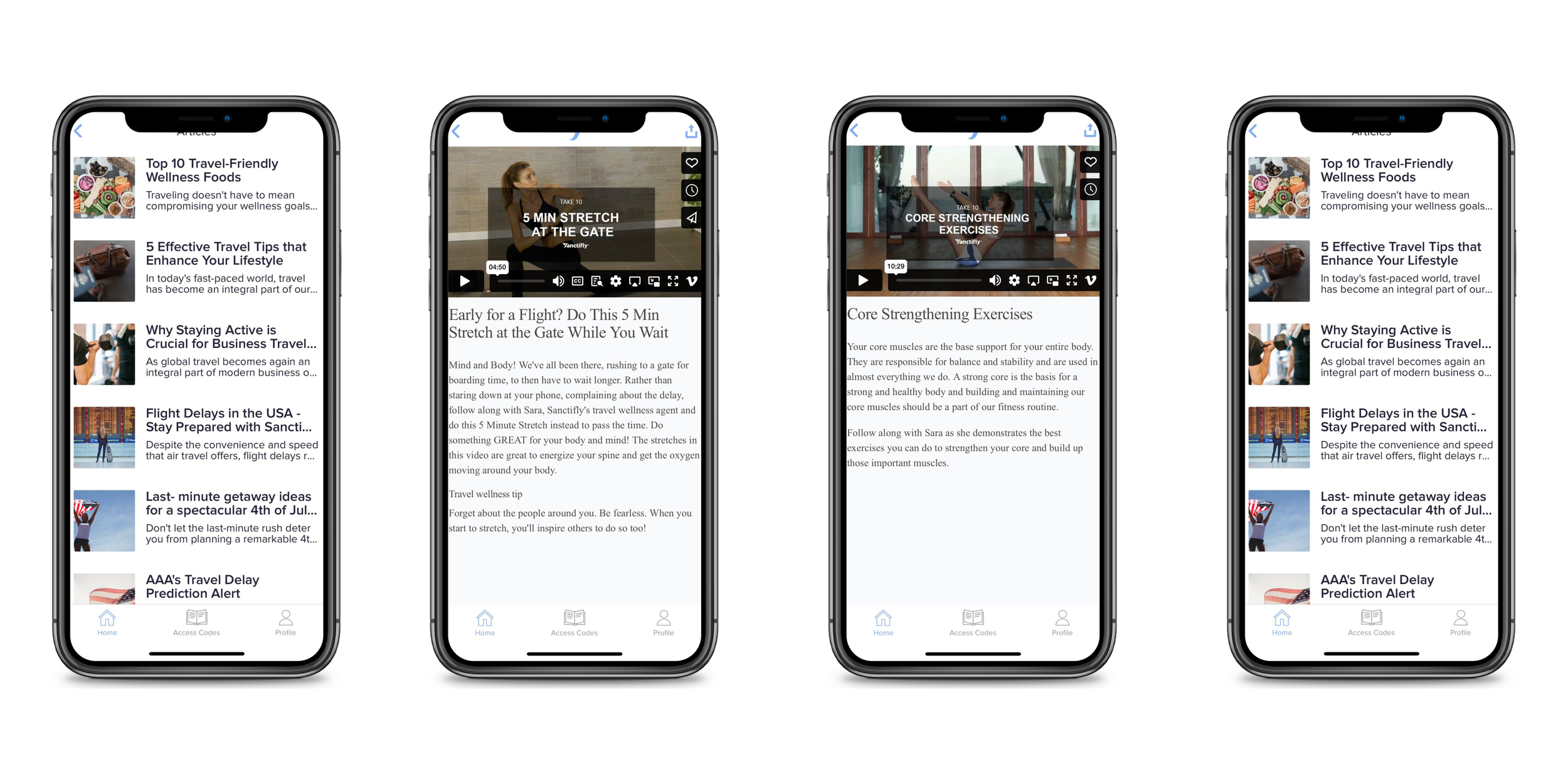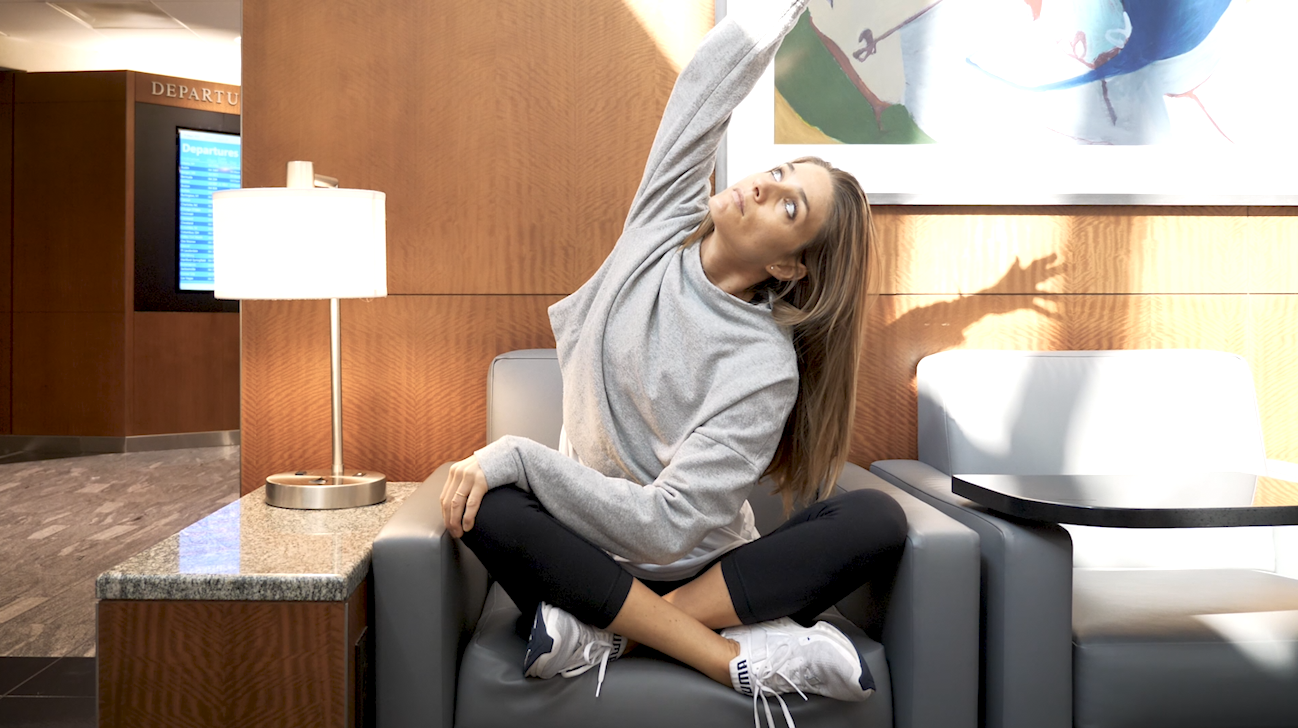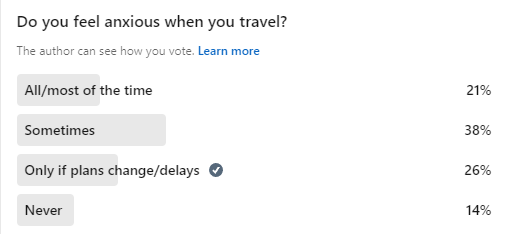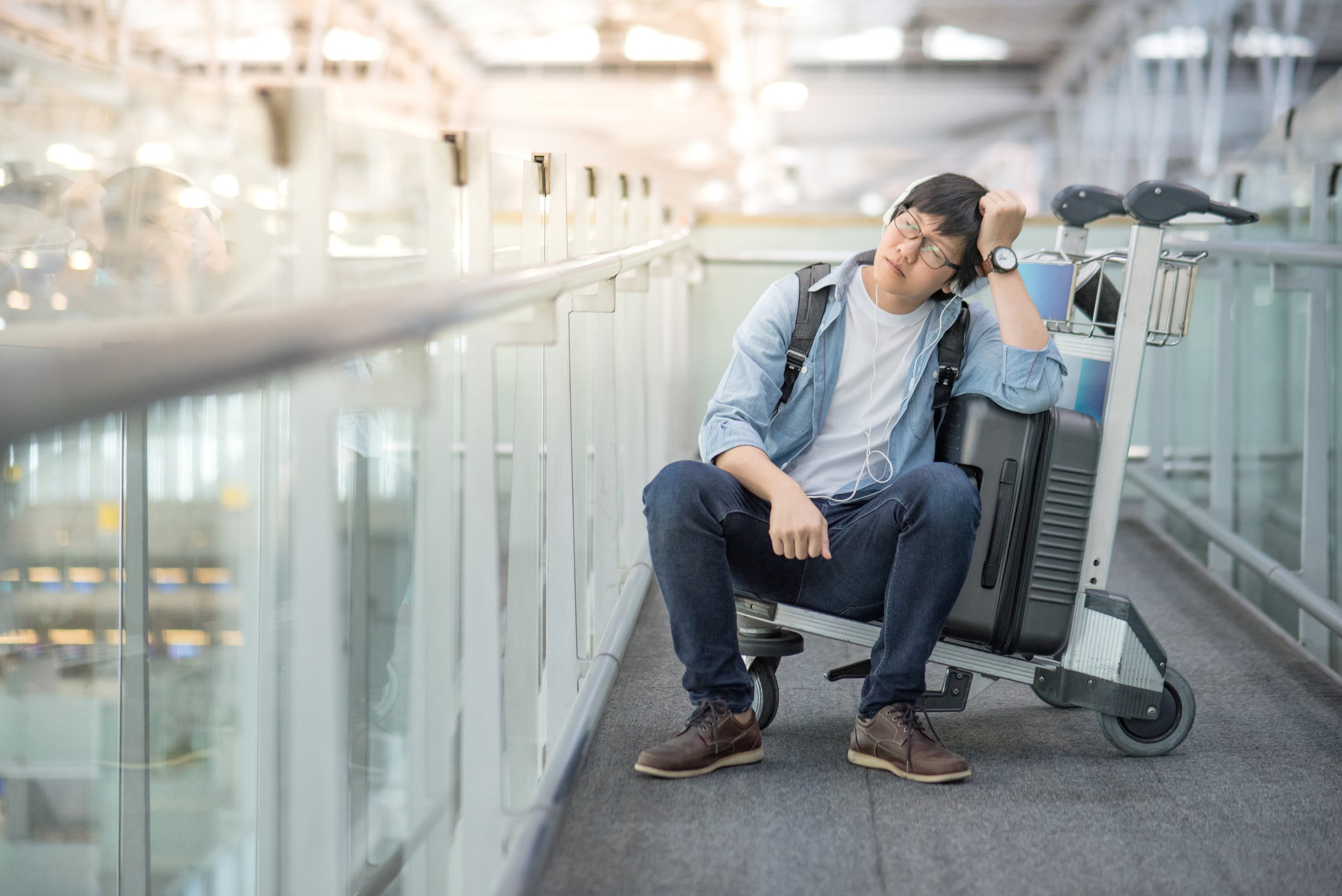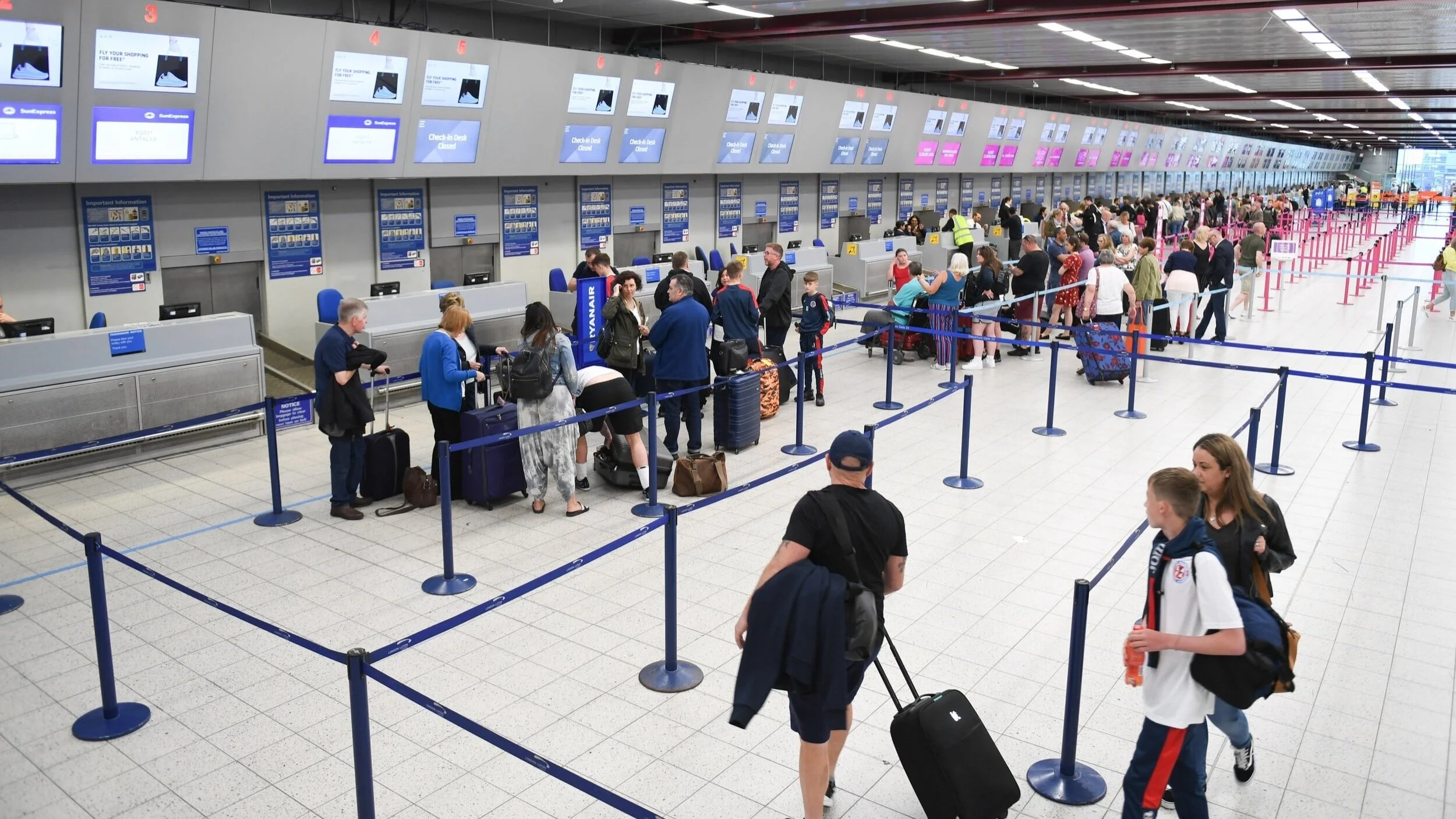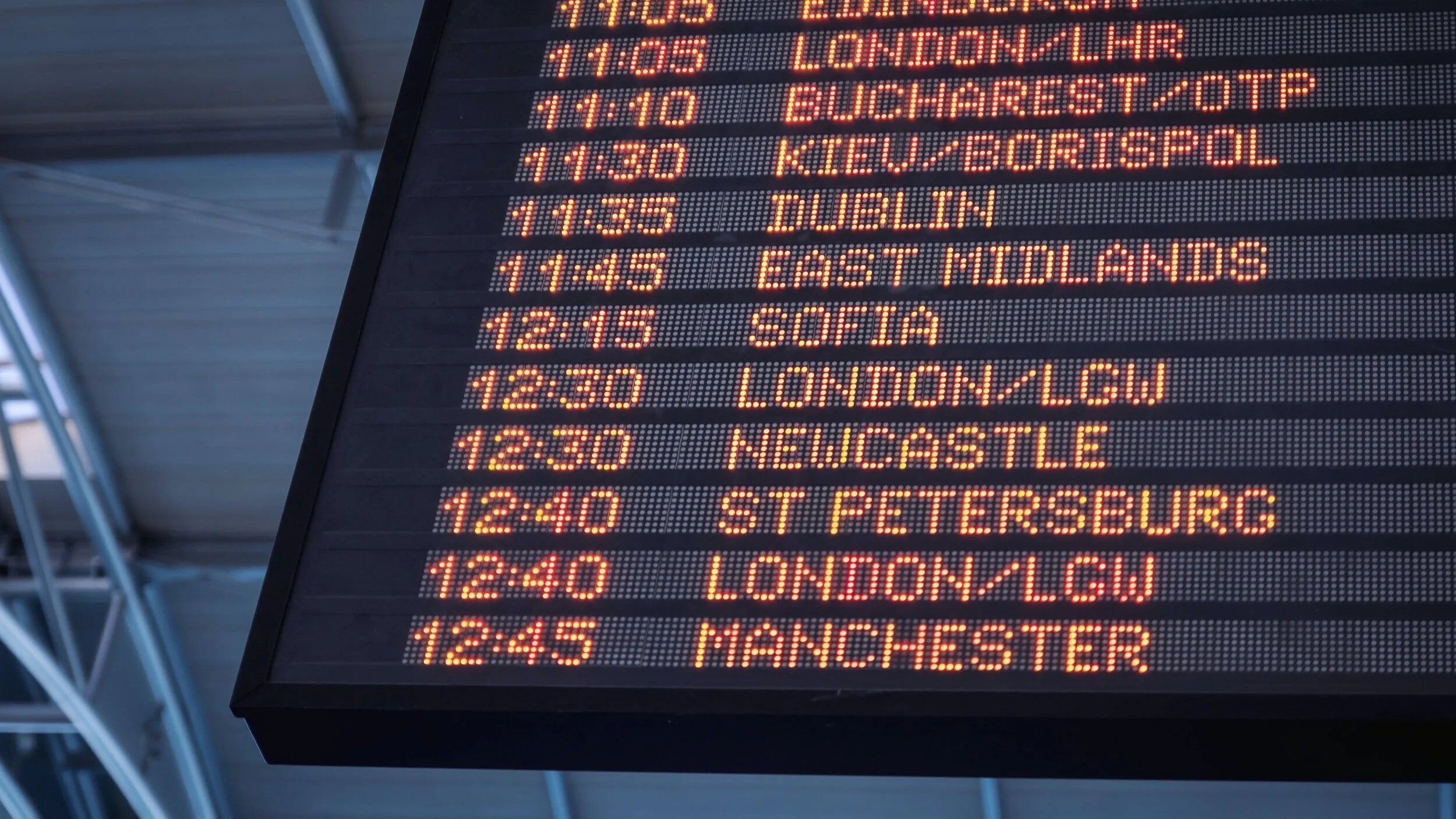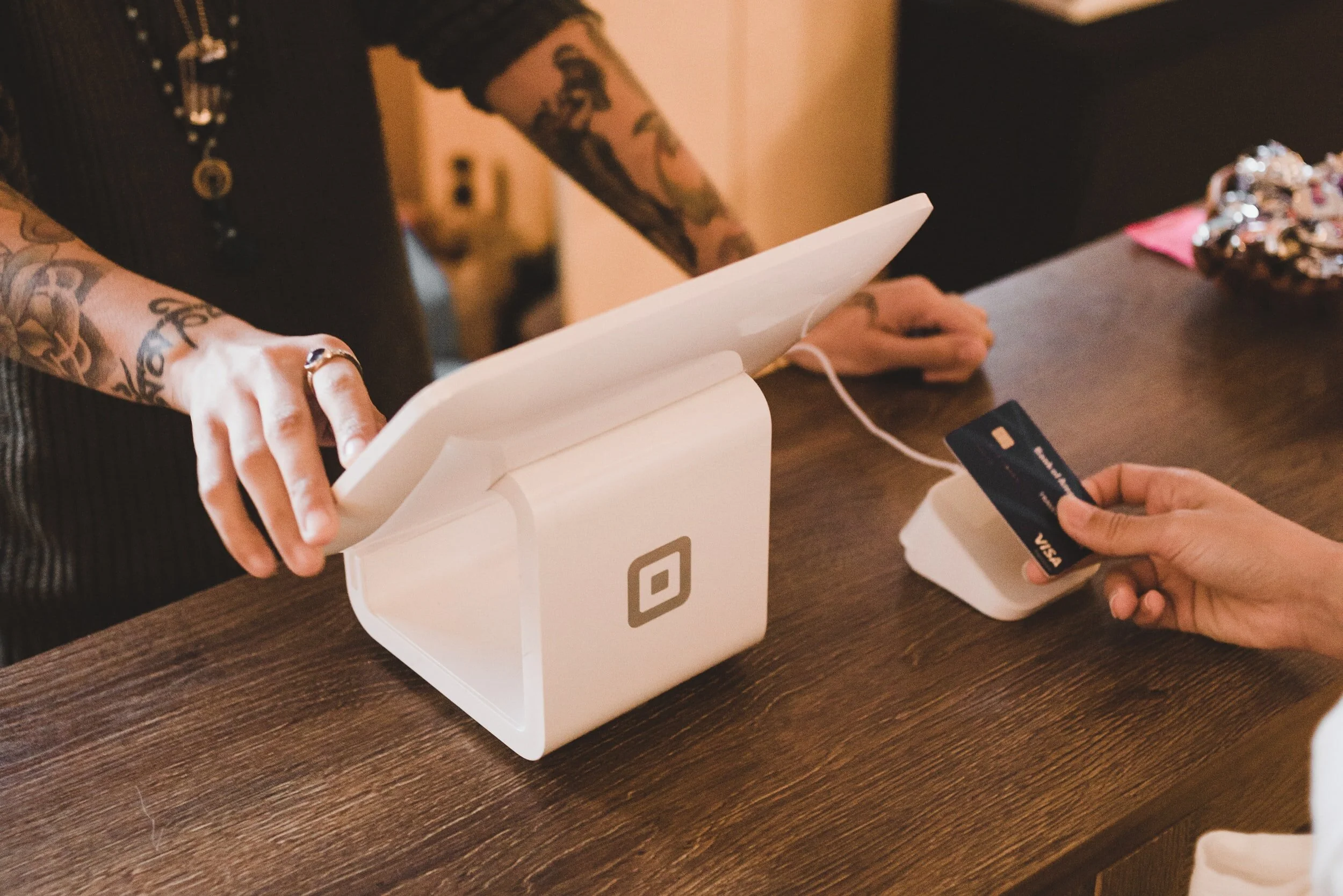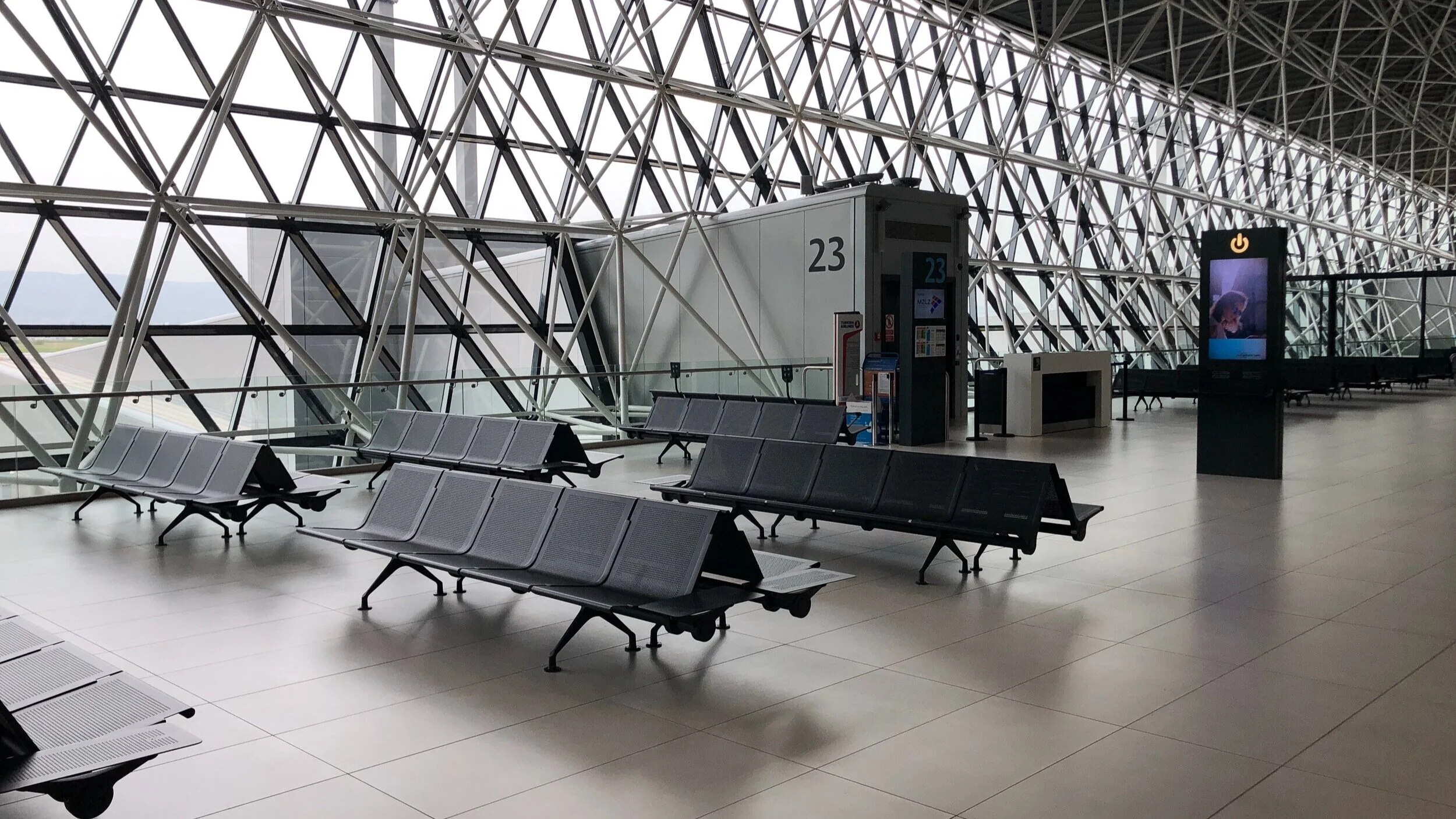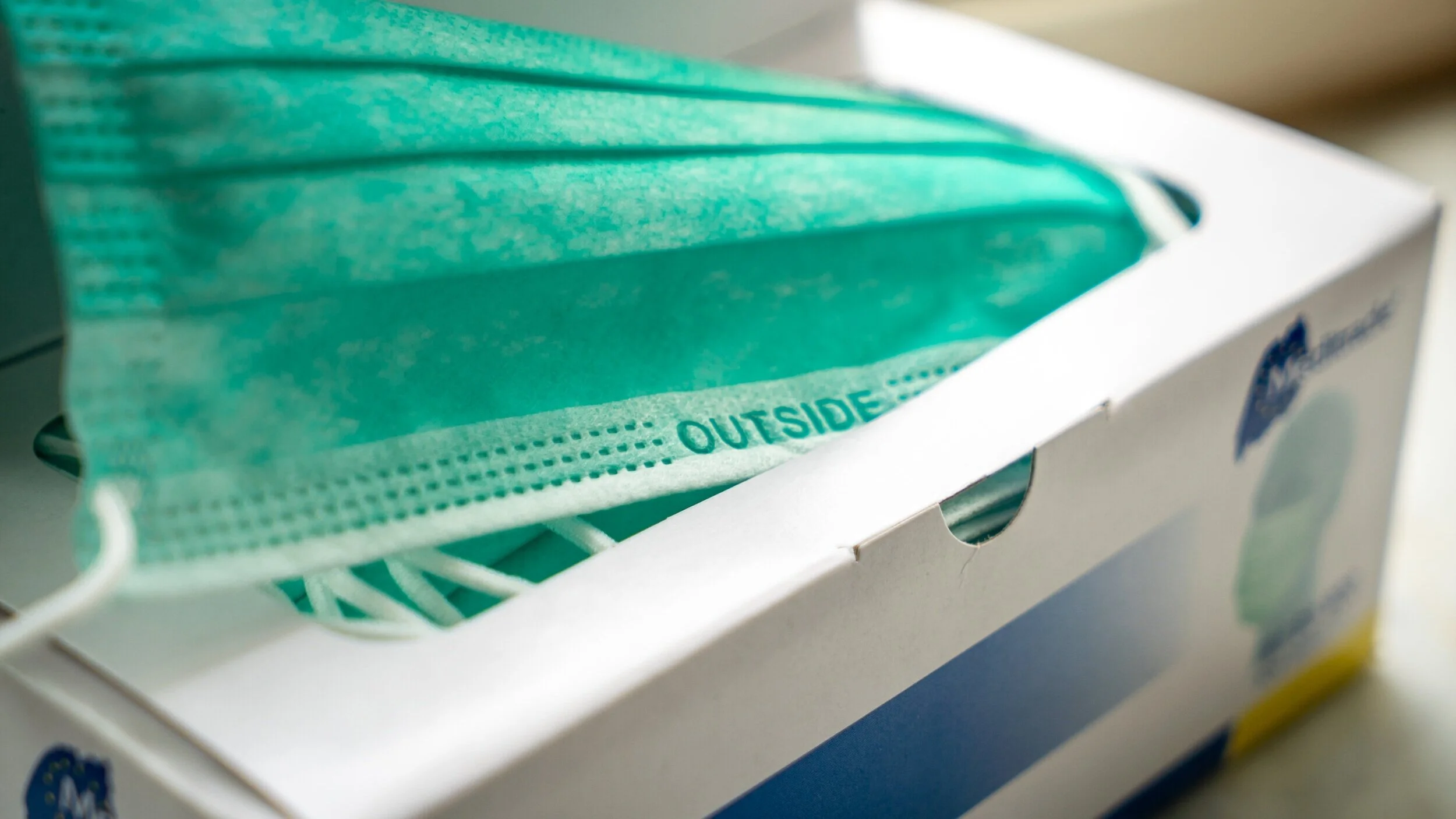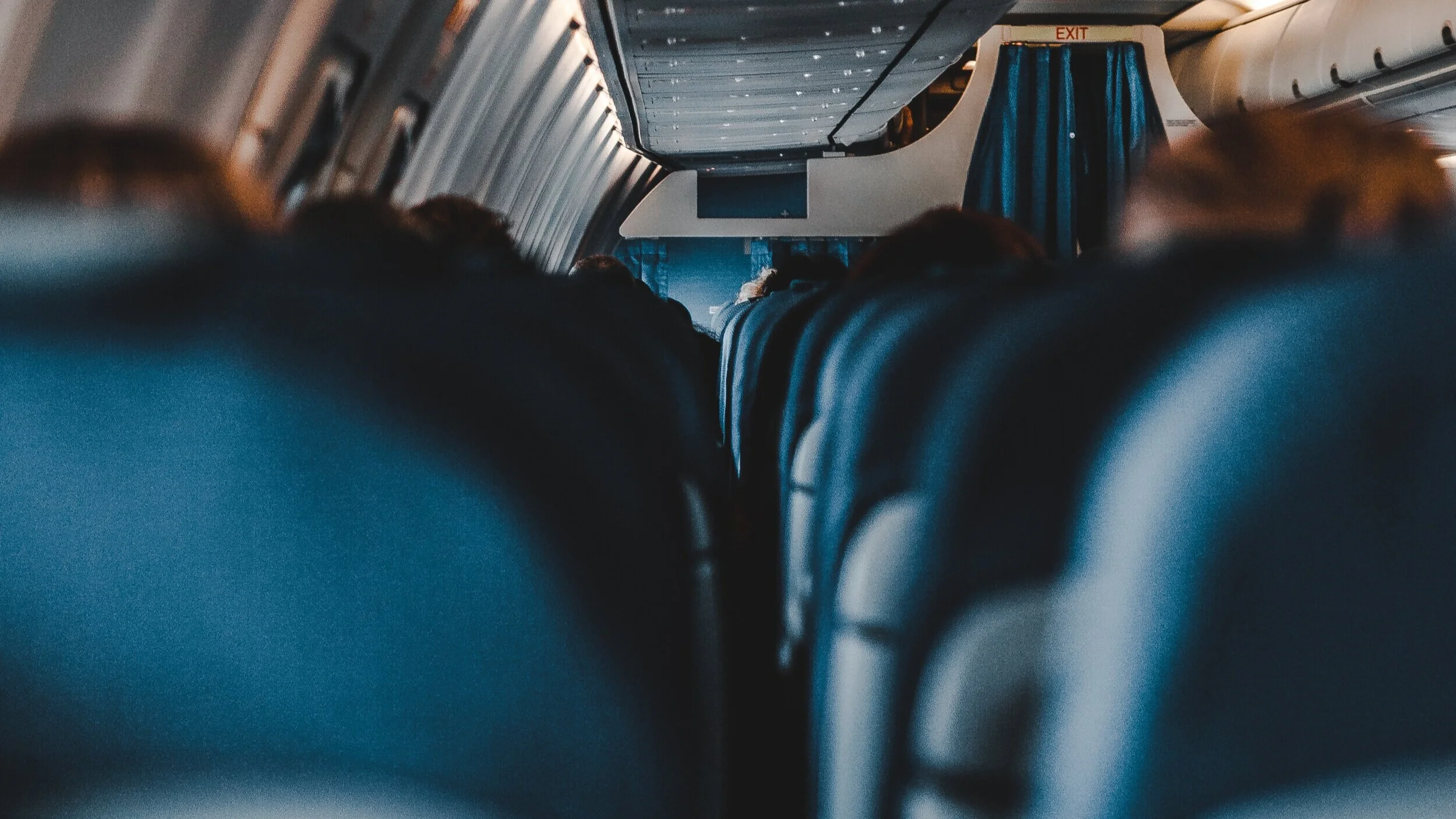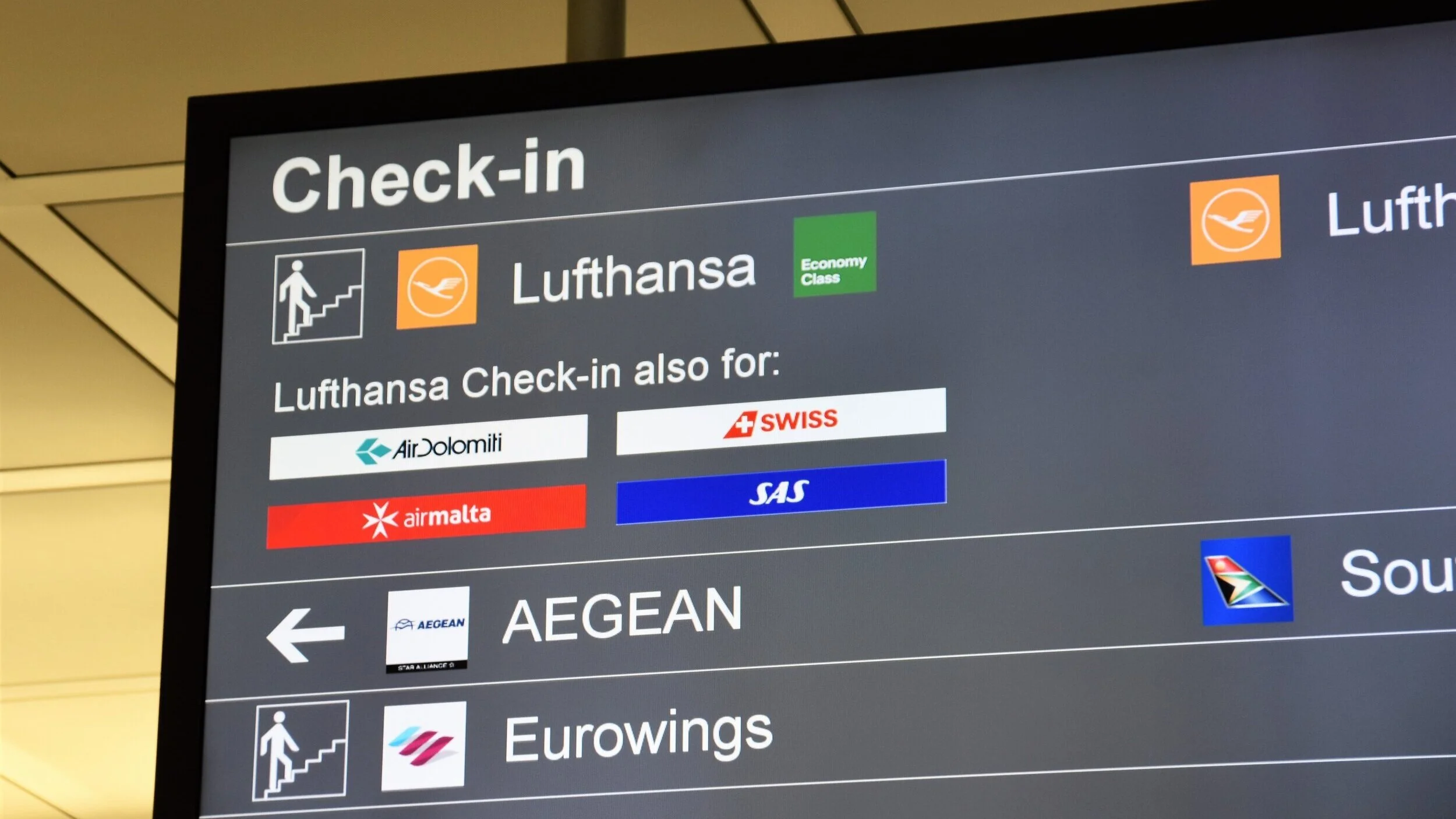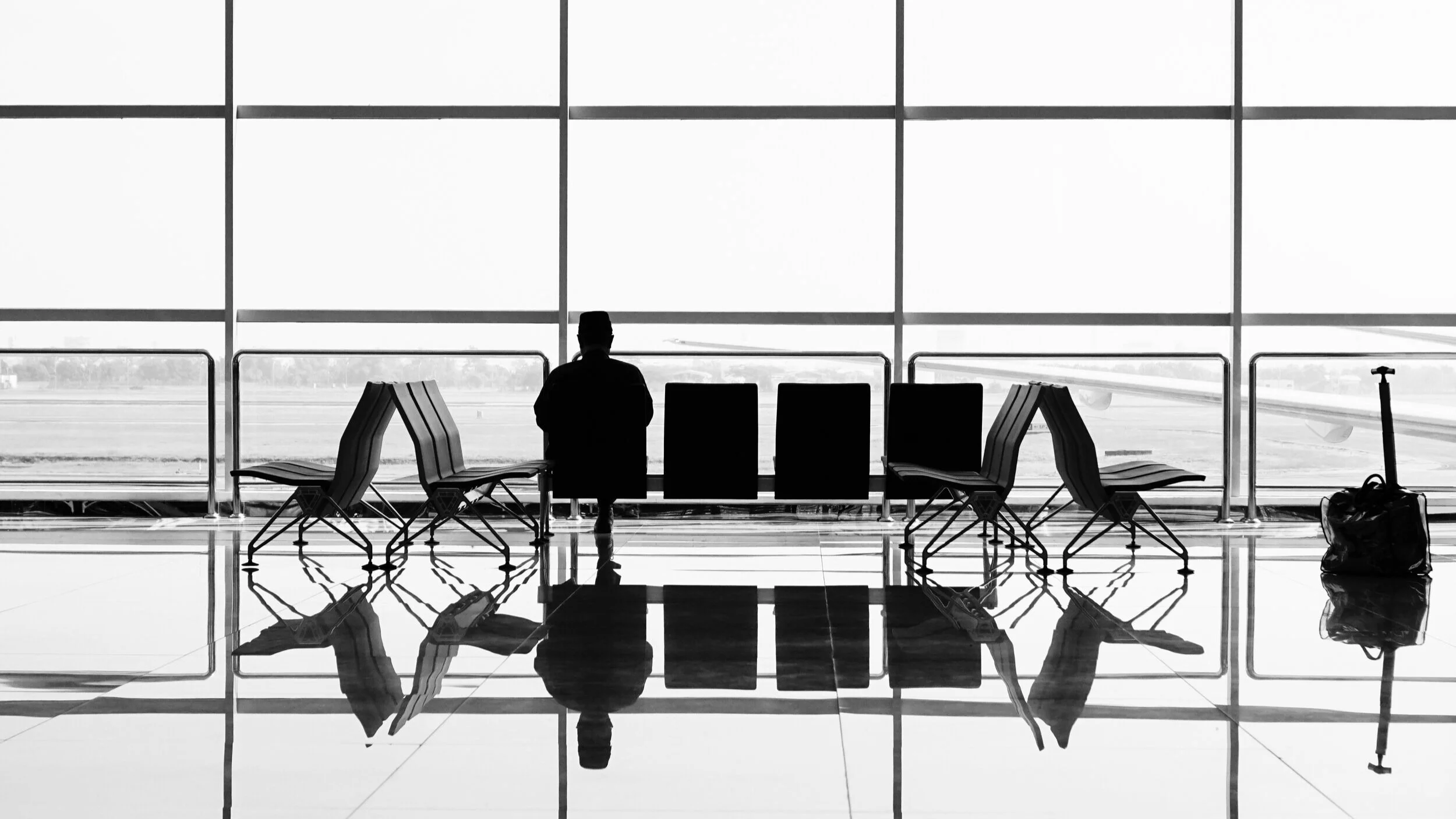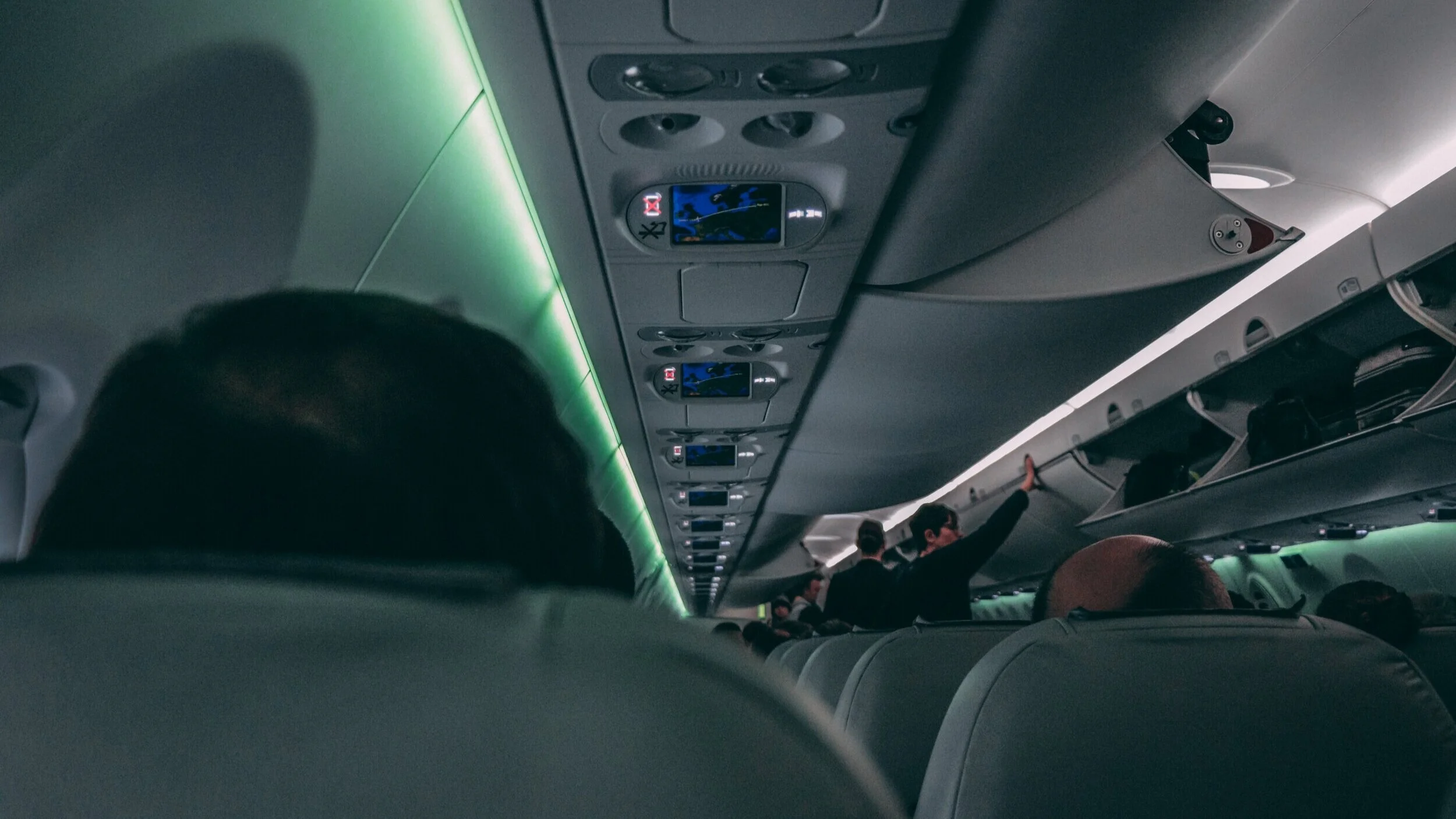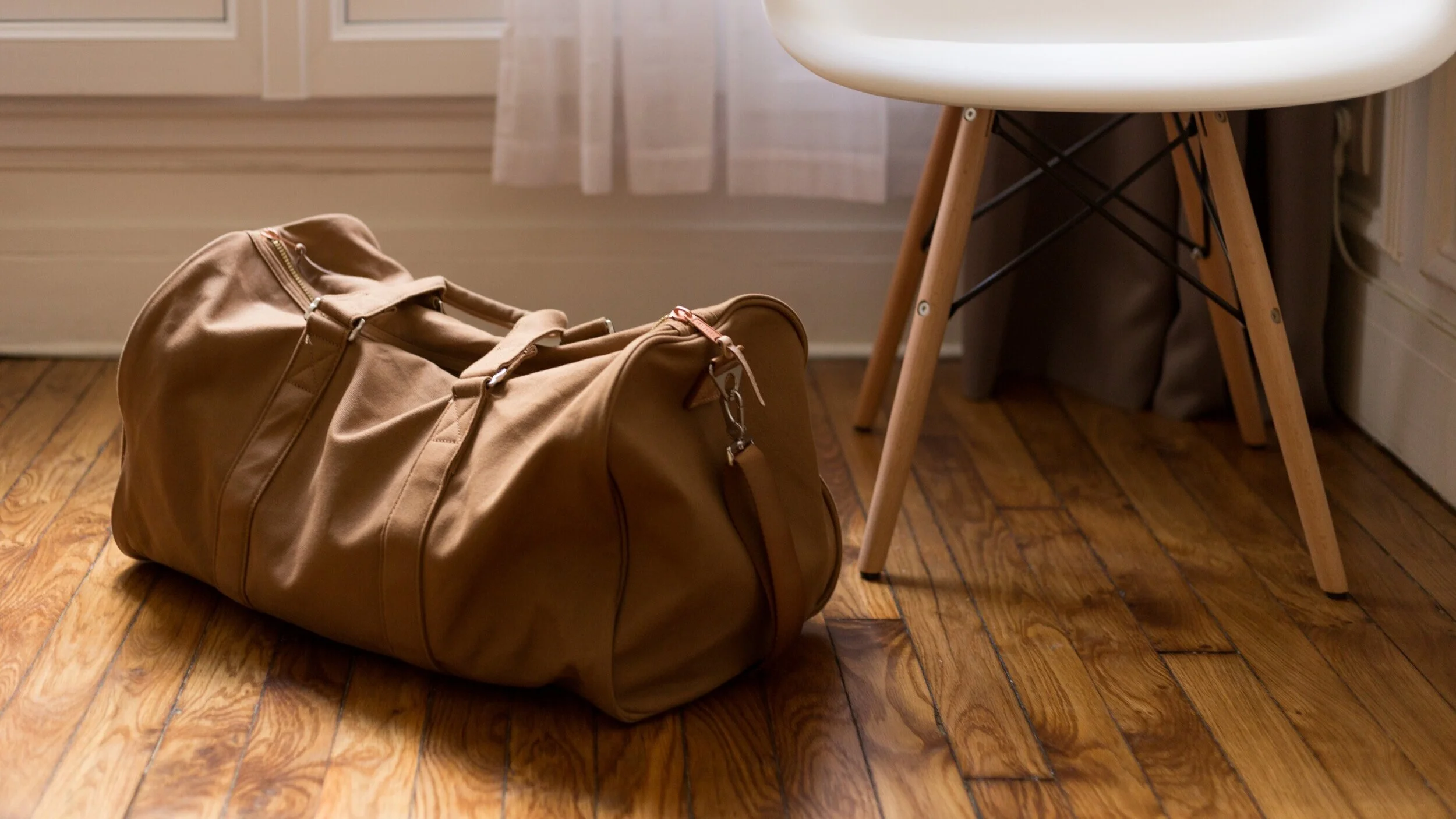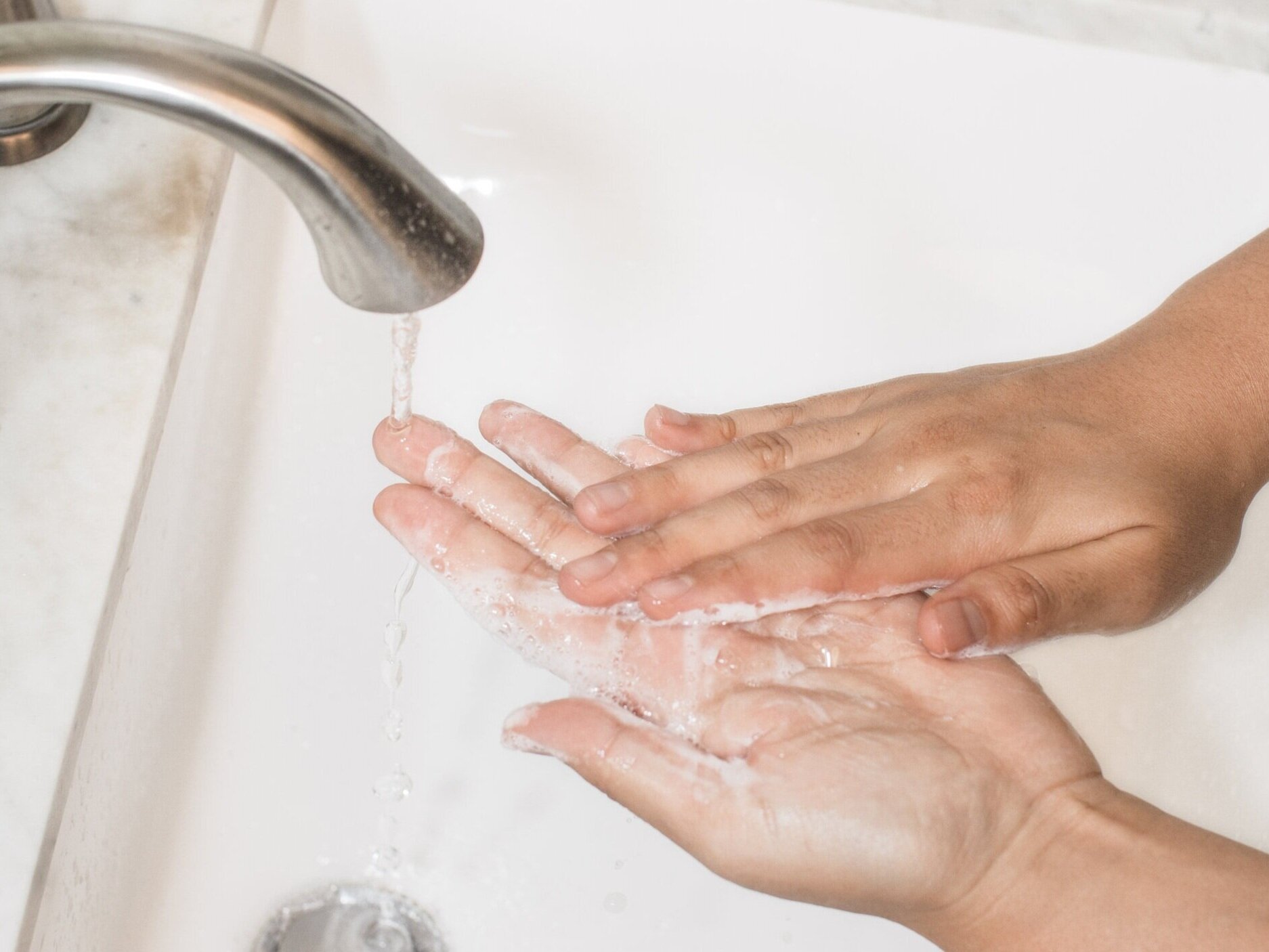How to save thousands $$$ on employee airport expenses in 2024
Since the return to travel, the cost of grabbing a quick bite and a glass of wine or refreshment at the airport has skyrocketed. The increased cost of labor, produce and food preparation, prices at the checkout have risen by up to 50% in the last two years. Regardless, business travel is an essential aspect of many companies, fostering partnerships, expanding market reach, and promoting collaboration. So the expenses associated with airport travel can quickly add up, impacting a company's bottom line. In fact, According to a study by the Global Business Travel Association, business travelers spend an average of $293 per day when traveling for work.
So, how can we better manage and control these expenses, ensure our team is getting the best value and are guided to better and healthier options for the airport downtime? By implementing smart strategies to reduce employee airport costs, ensuring that the business trips remain cost-effective without compromising productivity or comfort.
Strategic Flight Booking
Encourage employees to plan trips well in advance, taking advantage of early booking discounts and off-peak travel times. Getting in touch with travel management companies and signing up for a flight alert service like going can help you save 40-90% on roundtrip flights to destinations all over the world from your home airport.
Expense Policy Review
Regularly review and update your company's travel expense policy. Establish clear guidelines on allowable expenses and set reasonable limits. Providing employees with a comprehensive expense policy ensures transparency and helps manage costs effectively.
Expense Tracking and Reporting Tools
Implement robust expense tracking tools to monitor and analyze travel expenses. This allows for better understanding of spending patterns, identifying areas for improvement, and making informed decisions to optimize costs. Generate alerts for price discripencies when one travler is paying more fore the same airport service then an other ( e.g. lounge). Share Airport tips and hacks; best food, quiet zones, layover options. Share company wide, particularly when you use the same set of airports.
Educational Workshops and Tools
Offer workshops or resources to educate employees about cost-saving strategies and tools, such as fare comparison websites, budget-friendly accommodations, or efficient packing tips to avoid extra baggage fees.
Utilize Airport Lounges
Consider investing in airport lounge memberships or programs that offer access to various lounges worldwide. These lounges provide a serene environment, complimentary snacks, beverages, and amenities like Wi-Fi, enabling employees to relax and be more productive before their flights.
For companies with a high volume of travel, negotiating bulk purchases of lounge memberships can be a cost-effective solution. This not only ensures consistent lounge access for employees but also strengthens partnerships. Sanctifly is designed to do just that.
A simple solution to centralize all your employees' airport expenses, get them at the very best rates, and advise them on the very best and often exclusive options to spend their time. One corporate customer with over 50,000 travelers, reported a saving of over 50% on airport lounges expenses! Read more here.
How does Sanctifly reduce my airport expenses?
- We are always better value than the walk-up rate of the lounge, normally 30% better value. Anyone walking up to a lounge and paying at the door is paying top wack!
- Lounge deflection. We encouraged 55% of members not to go to the lounge, to enjoy an alternative walk, run, gym, spa or place to relax.
- We independently identify quiet zones and places to refresh or work, that cost a fraction of the lounge rate.
- If the flights are delayed we cover the full cost of the lounge or spa access (more detail)
- We can centralise all lounge access expenses to one corporate account and centrally report on all choices and activity.*
New in 2024: Business accounts start at only $99 per month for up to 100 employees. Right now Sanctifly is offering new corporate customers 50% off their first year (2024). Get in touch with us to know more
Minimizing airport travel costs and prioritizing employee comfort and well-being can positively impact morale and productivity while managing expenses effectively. By adopting these strategies, businesses can strike a balance between cost reduction and employee satisfaction, enhancing the overall travel experience.
Never eat breakfast at the airport AGAIN!!!
Image by Freepik
It was the week before Christmas (sorry, I couldn't resist it, because it's true!). 6am, I had just arrived at Edinburgh Airport off a short winter flight dark, cold and dull. The airport arrivals greeted me with uninspiring, prepacked, and overpriced food options along with the usual horde of bleary-eyed travelers, resembling zombies in their slumber on uncomfortable seating, while not-so-clean tableware lay scattered around. I had two hours of work to do and was hungry after my 3.30 am wake-up. This was not inspiring.
So, as per the recommendations in The Sanctifly App, I made the short walk (200m) to the Hilton Hampton. Bright, spacious, newly decorated lobby with ample seating choices on offer for relaxing, working or meeting. The hotel welcomes non-room guests from Sanctifly, and a delicious hot and cold breakfast buffet costs me only £9.95 (less than $15.00!).
I had cereal, juice, and coffee followed by eggs and toast. Perfect set up for the day! If you miss breakfast they have a 24-hour menu, so always welcome to drop in.
Quick shout out to the Moxy hotel just next door, also a super option, particularly if traveling with family. Shh.. they have got a game room.
Fully fed and watered (i.e. coffeed to the max!), I thoroughly enjoyed working for 2 hours in comfort with plenty of resources to recharge my tech and quiet zones to take a call. Well done to Kara Rose and the team at the hotel, a strong recommendation for any traveler to the Scottish Capital.
Let me extend a top traveler's tip - next time you get off an early flight, arrive early for a late night takeoff, or have a layover with a few hours to kill - check out the over 200 hotel options at airports that welcome Sanctifly members to use their lobby, lounge and restaurants (even take the shuttle if needed). It's our free members guide to better options for your downtime.
If you are an airport hotel and would like to be featured for free, register your hotel below.
The Remarkable Benefits of Ice Baths for Health and Wellness
You may have noticed famous athletes immersing themselves in a bath of ice after a challenging match, or perhaps you have a fitness enthusiast friend who champions the use of ice baths for recuperating after a grueling workout. This practice of taking a chilly dip is a type of cryotherapy commonly employed to manage various health issues employing cold temperatures. Despite its seeming resurgence in popularity, it is indeed a time-honored technique with a history spanning centuries of use for promoting health and well-being.
While the thought of submerging oneself in an ice-filled bath may not be universally inviting, this practice could potentially offer benefits to your physical and mental health. However, it's important to clarify that ice baths shouldn't be considered a panacea. The scientific research encompassing the advantages of ice baths presents a complex picture. Here's what you need to understand.
Tom Harvey highlights the benefits of ice baths here. So read on and discover what this therapy could do for you.
Exploring the Health Benefits of Ice Baths
Ice baths may not be as intense as whole-body cryotherapy, which typically involves short-term exposure to extreme cold conditions. Rather, ice baths involve a short immersion, generally spanning 5 to 10 minutes, in water chilled to a temperature between 50 and 59°F. Advocates of this technique use ice baths to alleviate muscle discomfort, reduce stress, and more. Now, let's delve into how the claimed advantages of ice baths reconcile with scientific findings.
The Impact on Inflammation and Swelling
Submerging your body in an ice bath causes your blood vessels to constrict due to the frigid temperature, consequently slowing the blood flow to your muscles. This, in turn, can potentially mitigate inflammation and swelling. According to several studies, this cold-therapy technique appears to be more effective in reducing post-exercise inflammation than other methods, such as wearing compression socks.
Soothing Sore Muscles
Subjecting your body to cold temperatures might provide relief to aching muscles. The exact mechanism is still under investigation by scientists, but it's postulated that the reduction in inflammation and decelerated nerve signaling could be responsible for this analgesic effect. An ice bath might also alter your pain perception, lessening the intensity of the discomfort. A systematic review found that ice baths could alleviate delayed-onset muscle soreness (DOMS) following exercise, though the quality of the studies was relatively low and optimal conditions for ice baths are yet to be determined. Moreover, preliminary evidence hints at the potential benefits of ice baths for chronic conditions like rheumatoid arthritis, gout, and fibromyalgia, although more research is needed in this area.
Enhancing Exercise Recovery
Upon emerging from an ice bath, your blood vessels dilate, resuming normal blood flow. This increased circulation, rich in nutrients, might aid in flushing out metabolic waste accumulated during workout sessions, another reason why athletes often use ice baths for post-exercise recovery. While some studies suggest that ice baths are an effective recovery method, a 2021 review indicated that while ice baths can reduce exercise-induced inflammation, they might also impede training adaptations essential for muscle growth and performance enhancement. The apparent trade-off needs further investigation.
Regulating Core Body Temperature
One obvious advantage of ice baths is their ability to cool down the body when you're feeling overheated. A study found that a mere 10-minute immersion in cold water can reduce core body temperature post-workout, helping to prevent heat-related conditions such as heat stroke and heat exhaustion.
Boosting Immunity
Preliminary research suggests possible immune-enhancing effects of ice baths. In a study, participants who combined cold water immersion with deep breathing and meditation exhibited fewer symptoms of bacterial infection than their counterparts who did not. However, the specific contribution of the ice bath to immune function is difficult to isolate due to the combination of methods used in the study.
Mental Health Benefits
Ice baths could potentially improve mental health as well. A study found that participants with gout who took a 20-minute ice bath four times a week reported an improved quality of life. They reported increased joint mobility and lower levels of stress, anxiety, and depression. Scientists hypothesise that the body's response to cold water exposure might activate the nervous system and trigger a stress response, enhancing mood and stress adaptation over time.
Understanding the Frequency of Ice Baths
Many sports persons recommend a swift transition to an ice bath following a strenuous workout, especially to alleviate the symptoms of Delayed Onset Muscle Soreness (DOMS). Some research findings also support this notion, indicating peak effectiveness within 24 hours following a workout. Moreover, some enthusiasts of this chilling therapy propose the idea of concluding each shower with a burst of cold water and adopting regular ice baths only when required, such as during episodes of muscular discomfort or pain.
Conclusion
Ice baths have surged in prominence as a strategy to recuperate after strenuous exercise, demonstrating efficacy in soothing muscle discomfort. They also bear the potential to uplift your spirits. However, they are not a universal remedy for issues related to physical or mental well-being. Therefore, it is advisable to consult with your healthcare professional before immersing yourself in their frosty embrace.
Posted in collaboration with SEO Partners
How to Boost Employee Satisfaction Through Travel Perks
In today's competitive job market, retaining top talent and enhancing employee satisfaction is paramount for businesses striving to thrive. One effective strategy that has gained prominence in recent years is offering travel perks to employees. In this article, we will delve into the various ways organizations can boost employee satisfaction through travel perks, exploring the benefits, strategies, and implementation considerations. Additionally, we'll introduce Sanctifly's Corporate Plan, starting at only $1.00 per traveler a month, which provides individual access to a myriad of health and travel wellness benefits on every business trip, including access to over 600 airport lounges like Plaza Premium, No.1., Escape, Air France, Virgin Atlantic, and many more.
Benefits of Travel Perks for Employee Satisfaction:
Enhancing Work-Life Balance: Travel perks such as flexible work schedules or remote work options allow employees to strike a balance between their professional and personal lives. This equilibrium contributes to reduced stress levels and higher job satisfaction.
Increasing Motivation: Providing travel incentives can serve as a powerful motivational tool. Employees are more likely to be engaged and enthusiastic about their work when they have exciting travel opportunities to look forward to.
Fostering Team Building: Team building is essential for a harmonious workplace. Companies can organize team-building retreats or off-site meetings at unique travel destinations, creating stronger bonds among employees.
Attracting Top Talent: Offering enticing travel perks can make a company more attractive to potential employees. It sets an organization apart in the job market and can be a decisive factor for candidates when choosing their employer.
Sanctifly's Corporate Monthly Plan
Sanctifly's Corporate Plan is a game-changer for businesses aiming to boost employee satisfaction through travel perks. Starting at only $1.00 per traveler a month, this plan offers individual access to a wealth of health and travel wellness benefits on every trip. Imagine your team members enjoying the benefits of access to over 2000 prestigious airport lounges, including Plaza Premium, No.1., Escape, Air France, Virgin Atlantic, and the list goes on.
With Sanctifly, you can effortlessly enhance your travel perks program, providing your employees with an unparalleled travel experience that includes relaxation, comfort, and wellness. Click here to get an exact quotation for your team and details on all the benefits they can get with Sanctifly.
Strategies for Implementing Travel Perks
Customized Travel Packages: Tailor travel perks to individual employee preferences. Some might prefer exotic vacations, while others might value the simplicity of weekend getaways. Personalization ensures the perks are meaningful to each employee.
Points-Based Reward Systems: Implement a points-based system where employees accrue points for achieving certain milestones or goals. They can then redeem these points for travel-related rewards like airline tickets, hotel stays, or even travel vouchers.
Collaboration with Travel Partners: Collaborate with travel agencies, airlines, or hotel chains to secure discounts or exclusive deals for your employees. These partnerships can make travel perks more cost-effective for the company while providing greater value to the employees.
Travel Stipends or Allowances: Provide employees with a stipend or allowance that they can use for travel expenses of their choice. This approach gives them flexibility and control over their travel experiences.
Considerations for Successful Implementation
Clear Communication: Ensure that employees understand the travel perks available to them and the criteria for eligibility. Transparent communication prevents misunderstandings and promotes engagement.
Budget Allocation: Allocate a specific budget for travel perks and regularly review its effectiveness. Adjust the budget as needed to maintain a balance between employee satisfaction and the company's financial health.
Feedback Mechanism: Establish a feedback mechanism to gather insights from employees about their travel experiences. Their input can help refine the travel perks program and make it more appealing over time.
Legal and Tax Compliance: Comply with relevant legal and tax regulations when providing travel perks to employees. Consult with legal and financial experts to ensure the program is in line with regulations.
Investing intravel perks for employees is a strategic move that can significantly boost job satisfaction and contribute to overall organizational success. By offering personalized perks, implementing effective strategies, and addressing key considerations, businesses can create a workplace that not only attracts top talent but also keeps them engaged, motivated, and satisfied. Plus, with Sanctifly's Corporate Plan starting at just $1.00 per traveler a month, the sky's the limit when it comes to enhancing your employees' travel experiences. Click here to get an exact quotation for your team today.
Unlock Your Smile: Top Tips for Maintaining Porcelain Veneers
Traveling is a time when we often find ourselves at our happiest, exploring new places and creating cherished memories. And what better way to enhance your travel experiences than by ensuring your smile is at its brightest? If you've invested in porcelain veneers to boost your confidence and transform your smile, it's crucial to maintain them even while on the go.
Porcelain veneers are an excellent choice for restoring and enhancing smiles that have dental issues such as discolouration or slight chips– but maintaining these thin shells is essential for keeping them looking their best over time. We'll give you the best maintenance tips for porcelain veneers to assist you. So continue reading to learn more!
What are Porcelain Veneers?
Porcelain veneers are super-thin, custom-made covers for your teeth that can instantly transform your smile. They're designed to cover the front surface of your teeth, the part that shows when you smile, to improve your appearance.
Crafted from medical-grade ceramic, these are made individually for each patient to compare one's natural teeth. It looks incredibly realistic and can resolve numerous cosmetic problems, ranging from crooked and gapped teeth to cracked or damaged enamel to noticeable whitening treatment-resistant staining.
It lies in their durability and resistance to stains, but like your natural teeth, they require proper care to shine their brightest. Gorgeous Smiles offers a wide range of cosmetic dental services, including porcelain veneers treatment.
The Advantages of Porcelain Veneers
Porcelain veneers are a typical cosmetic dental treatment due to their natural appearance and numerous advantages, including:
- Immediate transformation of your smile
- Stain-resistant material that looks like natural teeth
- Versatility to correct various cosmetic issues
- Minimally invasive procedure
- It can last up to 10-15 years with the right care
Before we get into the maintenance tips, let's talk about Sanctifly, a leading travel wellness club that aligns perfectly with the idea of maintaining your smile while traveling.
Sanctifly's mission is to revolutionize the travel experience by promoting health and well-being. They provide access to airport facilities and services that enhance your travel journey. Sanctifly offers access to 4000+ premium lounges, gyms and other travel wellness services at around 200+ airports in the world. This means that while you're on the move, you can maintain your health and appearance, ensuring your smile stays radiant throughout your travels.
Top 4 Tips for Maintaining Porcelain Veneers on the Go
Like other dental procedures, porcelain veneers need maintenance in order to endure. Here are the top four veneer care tips while you are traveling:
Pack Your Dental Care Essentials
Just like your travel essentials, make sure to pack your dental care items. Carry a travel-sized toothbrush, non-abrasive toothpaste, and dental floss to keep your veneers clean and plaque-free. If you're flying long distances, consider bringing a travel-sized mouthwash for a quick refresh during layovers.
Brush and Floss Daily
Just like your natural teeth, they need daily brushing and flossing to depose plaque and prevent decay. This practice is key to maintaining not just your veneers but your overall oral health. Make it a practice to brush at least twice a day using non-abrasive toothpaste, which won't scratch your veneers. Flossing allows you to clean the tight spaces between your teeth that your toothbrush can't reach. These simple yet critical steps will help sustain the brilliance of your porcelain veneers and enhance their lifespan.
Stay Hydrated
Hydration is essential for maintaining oral health. When you're traveling, it's easy to forget to drink enough water. Make a conscious effort to stay hydrated, not only for your overall well-being but also to prevent your mouth from becoming dry. A dry mouth can contribute to plaque buildup, which can affect your veneers.
Mind Your Diet
Traveling often involves indulging in local cuisine and treats, which is part of the fun. However, be mindful of foods and beverages that can stain your veneers, like coffee, red wine, and highly pigmented foods. Moderation is key. Try to balance your culinary adventures with tooth-friendly choices.
Additionally, professional cleanings can remove any stains or buildup that may occur over time, keeping your veneers looking their best. Make sure to plan regular visits with your dentist every six months or as advised by your dental professional. Looking after your veneers in this manner will not only prolong their lifespan but also protect your investment
Conclusion
Overall, porcelain veneers are an ideal option for those looking to enhance their smile. To keep their appearance and longevity, proper care is crucial. Following these tips will keep your porcelain veneers dazzling and make you smile for years. Remember, investing in yourself is worth it - especially when it comes to a healthy and radiant smile.
Posted in collaboration with SEO Partners
What is Orthotics and Who Needs It?
Exploring parts of the world is truly exciting as it lets us immerse ourselves in cultures, savor unique dishes and forge lifelong memories. Nonetheless for individuals the adventure can become slightly arduous due to foot discomfort or other foot related concerns. This is where orthotics step in and we're here to provide insight on this subject while introducing you to Sanctifly—a leading travel wellness club dedicated to enhancing your travel experience by ensuring comfort and enjoyment..
What is Orthotics?
Orthotics, in simplest terms, are devices designed to adjust and control the function of our feet and legs to treat an array of biomechanical issues. Imagine you've been experiencing foot discomfort or have been diagnosed with a condition that affects your foot function; you're likely to have come across the term 'orthotics.' But, understanding what exactly orthotics are, and more importantly, who might need them, can feel like navigating a maze. Don't worry! We're here to guide you through the ins and outs of orthotics. Always remember to choose orthotics recommended by a podiatrist. Otherwise, you might end up worsening your condition and even causing further damage. Orthotics are essential, for maintaining foot health while traveling. Sanctifly goes beyond that by providing a travel comfort experience. If you're someone who faces foot problems during your travels Sanctifly grants you access to premium airport gyms, relaxing spas, refreshing pools and luxurious lounges. With Sanctifly you can confidently explore the world knowing your feet are in good hands.
Types of Orthotics
Orthotics are available in various shapes, sizes, materials, and functions to cater to different foot conditions. Below are the three most commonly used types of orthotics:
Functional Orthotics Functional orthotics control abnormal foot function by correcting any biomechanical issues. They are designed to redistribute the pressure and forces exerted on your feet, thus reducing discomfort and preventing further damage. Functional orthotics are usually prescribed for conditions such as flat feet, high arches, or overpronation.
Accommodative Orthotics Accommodative orthotics, also known as cushioning orthotics, provide extra support and cushioning for the foot. They are often made from softer materials and used for conditions such as diabetic foot ulcers, plantar fasciitis, or other painful foot conditions.
Custom-made Orthotics Custom-made orthotics are precisely tailored to fit an individual's unique foot shape and address specific issues. They are designed based on a podiatrist's assessment of your feet, including gait analysis, pressure mapping, and 3D foot scanning. Custom-made orthotics are often recommended for severe foot conditions or those that have not responded well to other types of orthotics.
Who Needs Orthotics?
Orthotics can benefit a wide range of people, from athletes looking to improve their performance to individuals with chronic foot pain. Some common reasons why someone might need orthotics include:
- Traveling athletes looking to optimize performance and prevent injuries.
- Individuals with chronic foot pain due to conditions like arthritis, diabetes, or other medical issues.
- Tourists dealing with postural issues leading to discomfort during long walks and exploration.
- Jetsetters with foot deformities such as bunions, hammertoes, or flat feet.
However, the key takeaway here is that only a podiatrist can determine if you truly need orthotics. Their expertise is essential in identifying underlying issues and recommending the most suitable orthotic type for your specific condition.
What Are the Benefits of Orthotics?
Using orthotics can provide a range of benefits, including:
Pain relief: Orthotics can help redistribute pressure and support your feet, reducing discomfort and relieving pain.
Improved foot function: By correcting biomechanical issues, orthotics can improve the alignment and movement of your feet, leading to better overall foot function.
Injury prevention: Wearing orthotics can prevent further damage and injury to your feet, ankles, knees, and even back caused by foot-related issues.
Enhanced performance: For those adventurers who love staying active during their travels, orthotics can help optimize foot function and keep you on your feet longer.
Sanctifly offers a collection of travel tips, manuals and workout tutorials to provide you with the information and resources, for optimizing your travel experiences regardless of your location. Whether its learning exercises to alleviate foot discomfort during your trip or receiving expert guidance on exploring a city without putting too much strain on your feet Sanctifly aims to equip you with the knowledge and confidence needed to travel comfortably and confidently.
How Much Do Orthotics Cost?
The cost of orthotics can vary greatly depending on factors such as type, material, and customization. On average, orthotics can cost anywhere from $200 to $800 per pair. Private health insurance may cover some or all of the cost, so it's best to check with your provider beforehand. If you think you may need orthotics, make sure to consult with a podiatrist who can assess your feet and recommend the most suitable type for your condition. Don't be afraid to ask questions and understand the benefits and costs before making a decision. Ultimately, choosing the right orthotics can greatly improve your foot health and overall well-being.
When Is It Time to See a Podiatrist?
If you're experiencing foot pain or discomfort that is affecting your daily activities, it may be time to see a podiatrist. Other signs that you may need orthotics include:
- Difficulty walking or standing for extended periods
- Frequent tripping or falling due to foot issues
- Foot deformities such as bunions, hammertoes, or flat feet
- Chronic foot pain or discomfort that does not respond to home remedies
A podiatrist can assess your feet and determine if orthotics are necessary. They can also provide other treatment options, such as physical therapy, exercises, or footwear recommendations.
Conclusion
Orthotics are undeniably a valuable tool for treating foot-related conditions and enhancing overall foot health. They offer comfort and support to a wide range of individuals, from athletes seeking peak performance to those dealing with chronic foot pain. If you suspect you might benefit from orthotics, a consultation with a podiatrist is your first step towards happier, healthier feet.
And with Sanctifly your foot health and travel aspirations can now go hand in hand,, it's not just about getting from point A to point B; it's about traveling with ease, comfort, and style, ensuring that foot issues never hold you back from exploring the world. So, whether you're in need of a workout, a spa session, a refreshing swim, or a serene lounge to relax in, Sanctifly has your back, and your feet, making every step of your journey a pleasure.
Travel with ease, comfort, and style, making every step of your journey a pleasure. Don't let foot discomfort hold you back; take care of your feet and embark on your adventures with confidence.
Posted in collaboration with SEO Partners
Overcome Travel Anxiety: A Traveler's Guide to Deep Breathing Exercises During a Long Flight
Traveling, while exciting, can often come with its fair share of stress and anxiety, especially during long flights. For some, the very thought of embarking on a journey can trigger anxiety, commonly referred to as travel anxiety or flying anxiety. In this comprehensive guide, we will delve into the world of travel anxiety and provide you with step-by-step instructions for deep breathing exercises during a long flight.
Understanding Travel Anxiety
What Is Travel Anxiety?
Travel anxiety, also known as flying anxiety or fear of travel, is a psychological condition characterized by uneasiness, nervousness, and fear associated with the process of traveling. It can manifest in various forms, from pre-flight jitters to full-blown panic attacks during the journey.
Common Causes of Travel Anxiety
Travel anxiety can be triggered by a combination of factors, including fear of flying, fear of the unknown, concerns about safety, and the stress of navigating airports and dealing with delays.
Impact of Travel Anxiety
The impact of travel anxiety can be profound, affecting both the physical and mental well-being of travelers. It can lead to increased heart rate, muscle tension, and even digestive issues, making the journey uncomfortable and distressing.
Benefits of Guided Meditation for Travel Anxiety
Guided meditation is a powerful tool for reducing travel anxiety. It involves following the instructions of a meditation guide or a recorded meditation session to achieve a state of relaxation and mindfulness.
Meditation techniques help travelers stay calm and centered, allowing them to manage their anxiety more effectively. By focusing on the breath and being present in the moment, travelers can alleviate feelings of fear and stress. Regular meditation practice can have a positive impact on physical and mental well-being. It can improve sleep quality, reduce stress hormones, and enhance overall emotional resilience.
How to Meditate While Traveling: https://www.tourradar.com/days-to-come/how-to-meditate-while-travelling/
The Science behind Deep Breathing
Stress can wreak havoc on both our minds and bodies. It triggers a cascade of physiological responses, from increased heart rate to shallow breathing. Understanding this, we can appreciate the role of deep breathing in combating stress and anxiety. By engaging in deep breathing, you activate the body's relaxation response, reducing the production of stress hormones and promoting a sense of calm.
Preparing for Your Long Flight
Before you embark on your journey, it's essential to set the stage for a relaxed flying experience. Mental preparation plays a pivotal role in managing anxiety. Ensure that you have a clear understanding of your flight details and pack essentials like noise-canceling headphones, a comfortable neck pillow, and a good book to keep you occupied.
Deep Breathing Techniques
Diaphragmatic Breathing : Diaphragmatic breathing, also known as belly breathing, involves the use of the diaphragm to draw in deep, slow breaths. To practice this technique, sit comfortably and place one hand on your chest and the other on your abdomen. Inhale deeply through your nose, feeling your abdomen rise, and then exhale slowly through your mouth. Repeat this process, focusing on the rise and fall of your abdomen. This technique is highly effective in calming nerves.
Box Breathing: Box breathing is a structured technique that can bring about mental clarity and relaxation. Begin by inhaling through your nose for a count of four, hold your breath for a count of four, exhale through your mouth for a count of four, and finally, pause for another count of four before starting the cycle again. The rhythmic nature of box breathing can help soothe your mind.
Alternate Nostril Breathing : Alternate nostril breathing is a practice rooted in yoga and is known for its ability to balance the body's energy. Sit comfortably and use your thumb and ring finger to alternate closing one nostril while breathing in through the other. Then, close the nostril you just breathed in through and exhale through the opposite nostril. Repeat this pattern, focusing on your breath and the balancing sensation it provides.
4-7-8 Breathing : The 4-7-8 breathing technique is a simple yet potent exercise for reducing anxiety and promoting relaxation. Inhale through your nose for a count of four, hold your breath for a count of seven, and exhale slowly through your mouth for a count of eight. This pattern helps calm your nervous system, making it ideal for in-flight use.
To complement your flight routine, consider utilizing this step by step guided 5-minute breathing video by Sara Quiriconi- Travel Wellness Director, Sanctifly
At Sanctifly, we believe wellness should accompany you wherever you roam. That's why we offer our members an invaluable collection of meditation resources at no cost, ensuring serenity in every step of your journey. Download the App and explore the extensive Sanctifly library.
Coping with In-Flight Challenges
Traveling can present unexpected challenges, such as turbulence, flight delays, or crowded cabins. For these situations:
- During turbulence, focus on your breath, and remind yourself that it's a natural part of flying.
- In the event of flight delays, use deep breathing exercises to stay patient and composed.
- In crowded cabins, create your mental sanctuary through visualization and guided meditation.
It's worth noting that flight delays have been on the rise in recent years.Keep in mind that flight delays are not uncommon in 2023, according to EU flight compensation statistics there is a 4x increase in the flight disruptions. This data emphasizes the importance of coping strategies like deep breathing exercises. Understanding this can help you mentally prepare for potential disruptions in your travel plans.
Additionally, a recent poll conducted by Mathew Hollman, Founder of Simpila Mental Health revealed that a substantial number of travelers experience anxiety during their flights, further underscoring the need for effective anxiety management techniques.
How to Relax Before a Flight in 60 Seconds or Less: https://www.travelandleisure.com/airlines-airports/breathing-exercises-to-calm-pre-flight-nerves#:~:text=Use%20the%204%2D7%2D8,technique%20until%20you're%20calm.
Sanctifly: Your Travel Wellness Companion
Incorporating deep breathing techniques into your travel routine can be a game-changer. To help you prioritize travel wellbeing, Sanctifly, a leading travel wellness company offers access to 4,000+ lounges, wellness, relaxation, fitness, and leisure facilities at 200 airports globally so you can enhance your travel experience for just $11.95 a month.
In conclusion, travel anxiety need not overshadow your adventures. By incorporating deep breathing exercises, guided meditation, and the support of innovative solutions like Sanctifly, you can embark on your journeys with confidence and tranquility. Embrace the power of such tools, and let your future travels be filled with relaxation and joy.
Top 10 Travel-Friendly Wellness Foods
Traveling can be an exciting adventure, but maintaining a healthy lifestyle while on the road can sometimes be a challenge. The temptation of fast food and limited options can make it difficult to stay on track with your wellness goals. However, with a little planning and the right choices, you can enjoy nourishing foods that support your well-being even while traveling. In this blog post, we'll explore the top 10 travel-friendly wellness foods that will keep you energized, and we'll also introduce you to Sanctifly and its extensive library of tips and travel hacks to help you maintain your health and fitness routines while on the go.
Nuts and Seeds:
Packed with essential nutrients, nuts and seeds are perfect for snacking during travel. Almonds, walnuts, pumpkin seeds, and chia seeds are rich in healthy fats, fiber, and protein, providing lasting energy. They're easy to pack and can withstand hours of transit.
Fresh Fruits:
Portable and refreshing, fresh fruits like apples, bananas, and berries are natural sources of vitamins, minerals, and antioxidants. They're a great way to satisfy your sweet tooth while staying healthy on the road.
Quick Fruit Bowl : https://www.safefood.net/recipes/fresh-fruit-salad
Greek Yogurt:
A protein-packed snack, Greek yogurt is rich in probiotics that support digestion and boost your immune system. Opt for single-serving containers or pack some in a small travel container.
Benefits of yogurt: https://www.hsph.harvard.edu/nutritionsource/food-features/yogurt/
Hard-Boiled Eggs:
Eggs are a fantastic source of protein and nutrients. Hard-boiled eggs are easy to prepare in advance and can be conveniently packed for a quick and nutritious snack.
Are eggs good for you? : https://www.healthshots.com/healthy-eating/superfoods/why-boiled-eggs-are-good-for-weight-loss-and-what-are-its-health-benefits/
Hummus and Veggies:
Hummus, made from chickpeas, is a nutrient-rich dip that pairs perfectly with carrot sticks, celery, and cucumber slices. It's a great way to get your daily dose of fiber and plant-based protein.
DIY hummus: https://www.inspiredtaste.net/15938/easy-and-smooth-hummus-recipe/
Trail Mix:
Customize your own trail mix with a mix of nuts, seeds, dried fruits, and a touch of dark chocolate for a satisfying blend of flavors and textures.
Quick Trail Mix: https://www.kitchenkonfidence.com/2013/08/tamarind-trail-mix
Quinoa Salad:
Prepare a quinoa salad with chopped vegetables, herbs, and a light vinaigrette. This nutrient-dense option can be stored in a container and enjoyed on the go.
Best Quinoa Salad: https://cookieandkate.com/best-quinoa-salad-recipe/
Protein Bars:
Opt for natural, low-sugar protein bars that provide a quick and convenient source of energy. Look for those with whole-food ingredients and balanced macronutrients.
Homemade protein bar: https://www.rebootwithjoe.com/low-sugar-almond-oat-energy-bites/
Oatmeal Packets:
Instant oatmeal packets are not only easy to carry but also incredibly nutritious. They're high in fiber and can be prepared with hot water, making them an ideal breakfast choice.
Hydration Packs:
Staying hydrated is crucial while traveling. Carry a reusable water bottle and herbal tea bags to avoid sugary beverages and maintain optimal hydration levels.
Introducing Sanctifly: Your Travel Wellness Companion
Maintaining a healthy lifestyle while traveling doesn't have to be a challenge. Enter Sanctifly, your ultimate travel wellness companion. Sanctifly is a comprehensive platform that not only offers access to 3500+ premium airport amenities but also a wide range of wealth of travel tips, insights, and hacks to help you stay on track with your well-being goals, even when you're on the move.
From exercise routines that can be done in hotel rooms to mindfulness techniques for reducing travel-related stress, Sanctifly's library of resources empowers travelers to prioritize their health. And to give you a taste of what Sanctifly has to offer, here's a video showcasing some healthy snacks you can pack before you embark on your journey:
Traveling doesn't have to mean compromising your wellness goals. By incorporating these top 10 travel-friendly wellness foods into your journey, you'll be equipped with nutrient-packed snacks that keep your energy levels up. And with Sanctifly as your travel companion, you'll have access to a treasure trove of tips and hacks that will enhance your overall travel experience only at $11.95 a month. Remember, wellness and wanderlust can go hand in hand – all it takes is a little preparation and a dash of inspiration from Sanctifly's resources.
TRAVEL WELL WITH SANCTIFLY
5 Effective Travel Tips that Enhance Your Lifestyle
In today's fast-paced world, travel has become an integral part of our lives. Whether it's for business or leisure, traveling opens up a world of possibilities and experiences. However, without proper management, it can quickly turn into a stressful and overwhelming ordeal. This is where effective travel planning comes into play. It not only ensures smoother journeys but also enhances your lifestyle in numerous ways. In this blog post, we will explore five key benefits of effective travel and how it can significantly impact your overall well-being and enjoyment.
- Stress Reduction and Peace of Mind
Anyone who has experienced the chaos of last-minute flight bookings, hotel reservations, and itinerary changes knows how overwhelming travel planning can be. Effective travel planning takes that burden off your shoulders. With professional assistance and streamlined processes, you can bid farewell to the anxiety associated with travel logistics.
Read More: https://www.buzzfeed.com/michelleno/airplane-anxiety-relaxation-tips
- Time Optimization and Increased Productivity
Time is precious, and wasting it on tedious travel arrangements can hinder your productivity. Effective travel planning optimizes your travel schedule, ensuring that you reach your destination on time and in the most efficient manner. By leveraging advanced tools and industry expertise, travel Sanctifly can significantly help turn your layovers into productive ones incase of flight delays .
By saving time on travel logistics, you can allocate more of your day to meaningful activities. Whether it's exploring new places, attending business meetings, or simply relaxing with loved ones, your productivity and overall enjoyment will soar.
Read More: https://www.mindtools.com/acazjum/how-to-stay-productive-while-traveling
- Cost Savings and Value for Money
Traveling can often become expensive, especially if bookings are done haphazardly or at the last minute. Effective travel management can help you save costs and get the best value for your money. Travel management services like Booking.com, BCD Travel, TravelPerk, Navan (formerly TripAdvisor) have access to exclusive deals, discounts, and loyalty programs, which they pass on to their customers. Additionally, their expertise in budget planning ensures that you get the most out of your travel budget without compromising on quality.
By making smart travel choices, you can indulge in more experiences during your trips, like trying out local delicacies or exploring premium attractions. The cost savings can be substantial, making travel more affordable and enjoyable.
Read More: https://www.cnbc.com/select/how-to-save-money-on-upcoming-travel/
- Personalized Travel Experiences
Every traveler has unique preferences and needs. Effective travel management recognizes this and tailors travel experiences to suit your individual requirements. With specialized tools and personalized assistance, services like GetyourGuide, Navan (formerly TripActions) can help you curate itineraries that match your interests, whether it's a relaxing beach holiday, an adventurous trek, or a culturally immersive tour.
Moreover, travel management services often have a network of local partners and guides who can provide insider tips and recommendations, enriching your travel experiences and making them truly memorable.
Read More: https://www.travelinglifestyle.net/best-travel-planning-apps/
- Health and Well-being Benefits
Effective travel planning not only enhances your travel experience but also promotes your overall health and well-being. By reducing travel-related stress and optimizing your itinerary, you can avoid burnout and exhaustion during your trips. Properly planned travel also ensures that you have access to essential amenities, such as fitness centers and healthy dining options, to maintain your well-being while away from home.
Additionally, Sanctifly offer access to 3500+ airport wellness facilities, allowing you to relax and rejuvenate during layovers only at $11.95 a month. Taking care of your health during travel enhances your lifestyle by ensuring that you return from your journeys feeling refreshed and revitalized.
Conclusion
Effective travel goes beyond the logistics of planning a trip; it significantly enhances your lifestyle by reducing stress, saving time and money, personalizing your experiences, and promoting your well-being. By adding Sanctifly to your travel plans, you can unlock a world of travel wellness and create lasting memories during your journeys. So, the next time you embark on a trip, consider the invaluable benefits of Sanctifly; and elevate your travel experiences to new heights.
From Bored to Blissful: How to Improve Your Travel Downtime Experience
Travel downtime includes time spent waiting in lines at bus stops, airports, and train stations. It can be tiresome, uncomfortable, and even upsetting to travel frequently. Downtime while traveling, meanwhile, need not necessarily be a bad thing. In fact, it could be an opportunity to relax, recharge, and even have fun.
Making the most of your downtime when traveling is crucial since it can greatly affect how enjoyable your trip is in general. You'll feel more renewed, energized, and even delighted when you arrive at your destination if you make good use of this time. Additionally, it can aid in lowering the stress and worry that frequently accompany travel.
Plan Ahead for Entertainment Prepare for long periods of waiting: Plan beforehand if you anticipate having to wait a long time. Bring enough entertainment to keep you occupied for the entire time you will be idle. Bring a variety of items: Avoid relying solely on one form of entertainment. Bring a range of things, including books, music, podcasts, games, and even downloaded movies or TV shows. Consider the type of transportation: Some entertainment alternatives can be more practical than others depending on the form of transportation you're using. Consider taking noise-canceling headphones, for instance, if you're traveling by plane and want to listen to music or podcasts. Bring a book or audiobook to keep you engaged on long car trips. Balance entertainment with relaxation: While entertainment is important, it's also crucial to unwind during your downtime while traveling. To aid you in napping or practicing meditation while you're idle, think about carrying a travel pillow or eye mask. Stretch and Move Your Body During downtime during a flight, prolonged sitting can make your body weary and stiff. You can feel better overall and reduce these sensations by moving your body, even in modest ways. Moving around can boost energy levels, alleviate muscle stress, and enhance circulation. Additionally, it can lessen the chance of blood clots, which can occur after prolonged sitting.
Stretch
You may perform a variety of easy stretches and exercises while traveling, including ankle rotations, shoulder rolls, leg extensions, and neck stretches. Yoga positions like forward folds and seated twists can be performed in confined spaces. Your Sanctifly membership has lots of stretchs and exercises routines that you can use again and again. Designed for when you are at the airport, apublic space with minimum workout gear to hand. Check out the Video tab under any of the TIME tiles in App.
During your downtime, set a phone reminder to remind you to stretch every hour or so.
Try Something New
Trying something new during travel downtime can help you make the most of your trip and create unforgettable experiences. Here are some ideas for trying something new during travel downtime: Language learning: During layovers, stroll through the terminal of the airport or the train station. To assist you to keep accountable for moving about when traveling, think about utilizing a fitness app or a fitness tracker. Meditation: Meditation can help you unwind and achieve inner peace when traveling, which can occasionally be stressful and overwhelming. There are numerous meditation applications available that provide guided meditations for travelers, like Headspace and Calm. You may appreciate the beauty around you and keep your attention on the here and now by practicing meditation. Journaling: Journaling is a great way to capture your travel experiences and emotions. You can use a traditional journal or a digital platform like Evernote to document your journey. Journaling can also help you reflect on your experiences and gain new insights. Creating GIFs: Consider making GIFs from your travel images if you enjoy photography and want to attempt something creative during your downtime. You use a GIF compressor to easily create fun and animated GIFs. Trying something new during travel downtime can help you break up the monotony of waiting and create lasting memories. It can also provide you with new skills and insights that you can apply to your everyday life. Don't be afraid to try something that challenges you, as it can lead to personal growth and new experiences.
Connect with Others Never be hesitant to start a discussion with other passengers. You can start by inquiring about their origins, intended destinations, or favorite attractions or activities in the neighborhood. This can be an excellent opportunity to meet new people, exchange travel advice, and discover various cultures. If you're traveling alone, especially, connecting with others can make you feel less lonely and alone. You can learn about various cultures and practices, develop new relationships, and obtain fresh perspectives and insights as a result. You may get the most out of your trip experience and establish enduring memories by engaging with others while you're idle while traveling. Don't be frightened to engage in conversation with a stranger and leave your comfort zone. Who you might run across or what you might learn is always a mystery. . Conclusion There are numerous ways to make the most of your downtime while traveling, whether you're sitting in an airport line or taking a break from sightseeing. You can transform your downtime while traveling from a tedious waiting game into a joyful and fulfilling experience by making plans ahead of time, being active, trying new things, interacting with others, and taking care of yourself.
Keep in mind that traveling is about the journey as much as the destination. You may make priceless memories and improve your vacation experience by making the most of your downtime while traveling. Make the most of your time the next time you have some downtime while traveling by using some of these suggestions.
Ronie Salazar Guest Contributor,. Ron is from VEED. He is a passionate content marketer with a wealth of knowledge in the online space. His curiosity and enthusiasm led to the development of a constantly expanding portfolio that includes anything from video editing services to publishing his original creations on top-notch websites.
Travel Disruptions: How Brexit Affects Your Travel Plans
It has been quite a year for the travel industry. Many of us are desperate to travel overseas having missed out on holidays in 2020. Yet the prospect of travel in 2021 presents us with more uncertainty. Between COVID and Brexit, there are many things we need to consider before booking our first flight.
What Will Travel Look Like In 2021?
Many of us are desperate to travel overseas having missed out on holidays in 2020. Yet the prospect of travel in 2021 presents us with more uncertainty.
To simply plan a holiday requires assessing and making predictions based on the COVID situation. Also, if you are planning on traveling to and from the UK there are new regulations to consider post-Brexit.
To help you make an informed decision on when, where or whether to book, this article provides a simple overview of the 2021 travel situation.
Changes for UK Citizens Post-Brexit
Be aware that the new rules for UK citizens travelling in Europe only apply within the Schengen area.
The Schengen area covers 26 countries without border controls between them. These countries are: Austria, Belgium, the Czech Republic, Denmark, Estonia, Finland, France, Germany, Greece, Hungary, Iceland, Italy, Latvia, Liechtenstein, Lithuania, Luxembourg, Malta, the Netherlands, Norway, Poland, Portugal, Slovakia, Slovenia, Spain, Sweden and Switzerland.
Different rules apply in Bulgaria, Croatia, Cyprus and Romania.
Passports
You don’t need to replace your passport. If your UK passport says ‘European Union’ on the cover you can still use it, it just loses all of its EU powers. The only requirement is that your passport is valid for at least three months beyond your date of departure.
Tougher Border Checks
Before Brexit, border officials only checked to see if your passport was up to date and belonged to you. However, now they may ask for the purpose of your visit, where you plan to travel, how long you plan to stay and if you have sufficient funds.
Health
European Health Insurance Cards can continue to be used until the expiry date on your card, guaranteeing access to free medical treatment to UK citizens in the EU.
The EHIC will soon be replaced by a GHIC (global) card which will cover you for health treatment not just within the EU but also in countries where there are UK agreements in place, such as Australia.
Driving
You don’t need an International Driving Permit (IDP) to drive in the EU , Switzerland, Norway, Iceland or Liechtenstein if you have a photocard driving licence issued in the UK.
The main changes are regarding motor insurance. You will now need to carry a physical, paper copy of a ‘Green Card’ (which provides a multilingual translation of your car insurance) when driving abroad. Contact your insurance provider at least six weeks before your trip to obtain this.
Mobile Phone Charges
Sadly, UK citizens no longer benefit from the EU ban on roaming charges. Although the big phone providers have suggested they will not reintroduce these charges, they are now allowed to do so if they wish.
Some phone companies have said that they will now charge extra to those customers who spend half their time overseas. This means that retired people sending the winter months abroad or those with holiday homes wanting to use their 90 in 180 days allowance will be charged more for their UK mobile phones.
Pets
Pet passports which entitled the owner to easily take their dog or cat into the EU are no longer valid.
Pet owners must now obtain an EU Animal Health Certificate, for which the animal must be micro-chipped. At least 3 weeks before travelling your pet must have a rabies vaccination and dogs must be given a tapeworm treatment between one to five days before entering the EU. These details will be recorded on the health certificate.
How much time can UK residents can spend in the EU?
One of the biggest setbacks of Brexit is that the amount of time you can spend in Europe is now vastly reduced. Without residency or visas, even those who own EU homes will only be allowed to spend 90 days (about three months) in any 180 (six months) in the Schengen area.
Once you have spent a total of 90 days in 180, you are not be allowed to visit any EU country for the following three months. For example, if you spent three months in Spain from December you won’t be allowed to re-enter any country in the EU until June.
However, the 90 day rule does not apply in Bulgaria, Croatia, Cyprus and Romania. You can visit these countries without it counting towards your 90-day total.
Is this the end of living in Europe part-time?
Thankfully, it is still possible to spend longer in your favourite Schengen area country although it will mean applying for a visa.
These are reasonably priced but require you to prove you have medical insurance and sufficient funds to support yourself while you are there.
France has a one-year visa which costs €99. In addition to the above, you’ll also need to provide evidence of your accommodation.
Spain has a long-stay visa priced €60 which requires both health insurance and a medical certificate, proof you haven’t broken the law in the past 5 years and at least £2000 per month for your intended stay.
The situation in Italy is somewhat different. Whereas in France and Spain you can arrange a long-stay visa without applying for residency, in Italy, it is not possible to apply for one without the other. With an Italian long-stay visa, you can enter Italy, but you must get your Italian residence permit, to authorize staying for more than 90 days.
How Brexit affects travelers planning to visit the UK
At the moment, EU citizens can visit the UK with national ID cards. But from 1 October 2021, you must show a valid passport and travel documents covering the dates of your trip. Your passport should be valid for the whole of your stay in the UK. Under the new system, if you’re an EU, EEA or Swiss citizen, you can visit the UK without applying for a visa and in most cases, will be able to stay for up to six months.
Nothing has changed for non-EU/EEA visitors following the end of the Brexit transition period.
How COVID-19 is affecting travel as 2021 begins
The most significant factor shedding doubt on our travel plans is COVID-19.
For the moment, UK citizens are not permitted to leave the country except for work or for those with residency outside the UK to return to their homes.
The majority of the EU is also under lockdown restrictions. The EU uses a traffic light map as a guideline to the high risk countries (signalled in red) from which travel should be limited. At the moment the only green, (safe and unrestricted ) area in Europe is a small section of Greece.
The following section examines how the variables of COVID are shaping up. This should help you to predict if a booking for summer 2021 is likely to come to fruition.
Why we can’t rely on the ‘R’ rate as a predictive measure
The R rate, which gives a measure of how quickly the virus is spreading, is used by many countries to enforce restrictions. Last year, we saw how the R rate affected whether a country remained on ‘safe to travel’ lists. However, now that we have lived through repeated waves of the virus, we know that even if your preferred destination has a low R rate now this doesn’t mean it will remain low in the months ahead.
How will vaccination programmes affect travel in 2021?
The beginning of COVID-19 vaccination programmes have provided us with our first real glimmer of hope. As the Pfizer vaccine seems to also protect people from new strains, we hope that a return to activities like travel might not be too far away.
Here are answers to the important questions on COVID vaccines and travel
What percentage of the population needs to be vaccinated before things improve?
When so many people are vaccinated that the virus struggles to find people to infect, COVID will no longer pose such a threat. This is what is known as achieving ‘herd immunity.’
The number of people needing to be vaccinated to achieve herd immunity depends on how infectious the virus is. As some strains of COVID-19 (such as the UK and South African) are reportedly more contagious, this could mean the ‘critical vaccination level’ will need to be higher.
The higher the critical vaccination level, the longer it will take to achieve.
Will COVID vaccination passports be available for travel?
There is speculation that a document will be available to those vaccinated which will enable them to travel. However, scientists are not yet certain whether the vaccine only prevents COVID symptoms. It is possible that, like the flu vaccines, those vaccinated will still carry the virus. In this case, being vaccinated wouldn’t mean you posed no COVID threat.
Will being vaccinated prevent me from spreading the virus?
It is expected that this information will be available from clinical trials soon. However, this article from a researcher at Cambridge University gives us cause to feel positive.
It explains why the vaccine will help defeat COVID even if it doesn’t stop us from carrying the virus. Briefly, this is because carriers with no symptoms transmit less of the virus. Therefore, ‘vaccinated people are less likely to transmit enough virus to cause severe disease.’ So, even if the vaccine doesn’t prevent us from carrying the virus, it will help prevent those we infect from becoming seriously ill.
How COVID will continue to affect travellers
Although the ongoing vaccination programmes will eventually help defeat the virus, herd immunity won’t be achieved quickly. Unless the vaccine proves to prevent us from carrying the virus, those who have been vaccinated won’t be granted exemption from restrictions or other preventive measures.
COVID travel protection measures, (such as testing before flying and/or a requirement to quarantine) are likely to be present for most of 2021, as will wearing masks and social distancing.
The return to travel and holidays as we knew them is still a long way off.
Tips should you decide to book
Restrictions around international travel in 2021 are likely to be constantly changing. However, if you are eager to book try these tips to improve the chance of an exchange or refund.
The best way to protect yourself from losing money on your 2021 holiday is to book a package through an ATOL protected company which means you will get a full refund within 14 days.
Be aware that your entitlement to a refund depends on whether or not your operator actually cancelled the booking. If they cancelled, you are eligible for a refund. If your plans change and you can no longer travel, most companies don’t have to offer an exchange or reimburse you.
As a result, airlines such as British Airways and Easyjet have started to offer flexible holiday bookings should you need to change your plans. Although you must inform them of changes 3 to 4 weeks before departure, this should make a booking, (if not confidence-inspiring) somewhat less risky.
Contributed to the Sanctifly Travel Wellness blog by Caroline James, journalist and editor of Immigration News UK
What Do Travelers Need To Feel Safe On The Road?
Many surveys suggest that travelers are eager to start exploring again, however only if their safety concerns are met. Plaza Premium Group conducted a survey where they asked over 2000 travelers their thoughts and expectations on travel in 2021 when they expected to travel, and what would be vital to make them feel safe. Here are some of the key points found in the survey.
2020 was the year of grounded flights and canceled trips. It is a brand new year, and we are so excited to get traveling again, and we are not alone. Many surveys suggest that travelers are eager to start exploring again, however only if their safety concerns are met. Feeling safe and staying healthy is going to be the top concern for travelers in 2021 and beyond. We have spent a lot of time writing about what airports are doing to help passengers navigate the new normal as they return to travel. But it is equally important to understand what travelers want and what they consider the most important.
Plaza Premium Group conducted a survey where they asked over 2000 travelers their thoughts and expectations on travel in 2021 when they expected to travel, and what would be vital to make them feel safe. Here are some of the key points found in the survey.
Source: https://issuu.com/plaza-network/docs/what_is_the_new_normal_in_airport_h_370336b93f6aca?sc_src=email_4088035&sc_lid=207579285&sc_uid=rHkDaHb8tY&sc_llid=6966
49% of travelers consider hygiene and safety a priority.
There has been a strong focus on hygiene and safety in the last year across all industries. It is no surprise that travelers need to know that airports and airlines are making it a top priority in order to feel safe. The crowds, enclosed spaces, and multi-touch surfaces associated with air travel need to be addressed, and airports and airlines need to prove to customers that they are doing everything they can to make the spaces safe. Airports and airlines should be introducing measures such as increased cleaning and hygiene protocols, contactless processes, staggered arrival times, and social distancing.
83% consider airport lounges and in transit hotels essential.
This is an interesting one. Presumably, it only applies if airport lounges either have private spaces travelers can book or drastically limit the capacity. Anyone who has spent time in a busy lounge pre-Covid will know they are not the best spaces to stay away from other travelers. However, if lounges limit numbers and apply social distancing measures, they could become sanctuaries for weary travelers. And access to lounges and to private rooms in transit hotels will become a highly sought after benefit that travelers are willing to invest in. Access to these spaces will become a must-have benefit in credit card, airport reward, and travel wellness programs, such as Sanctifly.
83% of travelers consider wearing a mask as the most important preventive measure during travel.
Studies show that masks reduce the spray of droplets when worn over the nose and mouth, therefore preventing your respiratory droplets from reaching others and, when others wear them, preventing their respiratory droplets from reaching you. Masks are most effective when everyone wears them and travelers are recognising this. The problem occurs when everyone is not on the same page. Airports and airlines can help to support travelers by enforcing mask-wearing in the airport and on the flight.
Check out this article for tips on the mask hygiene.
While wearing a mask is considered the most important preventive measure, according to travelers, there are many other measures that should also be implemented by the air travel industry. These include:
Body temperature checks
An elevated temperature is a key indication that you have contradicted Covid-19. While everyone should be monitoring their temperature themselves and stay at home should they notice a change, this is not always feasible. Airports and airport facilities, such as lounges, should implement temperature checks in order to screen passengers.
Availability of hand washing facilities and sanitizer
Wash and sanitize your hands was the calling card of 2020 and it will continue into 2021. The availability of handwashing facilities and hand sanitizer should be widely available across airports and on planes. While it is expected that the airport or airline will provide access to these items, bringing your own can bring great peace of mind. The TSA recently increased the liquid allowance for hand sanitizer in carry-on luggage from 3.4 oz to 12 oz so that travelers can bring larger quantities on their trips. Please note that this increase does not apply to other liquids. Travelers can also pack some disinfectant wipes to wipe down the seat and tray table when boarding the plane. Again, the airline will have hygiene protocols in place for between flights, however, for peace of mind, it can be good to do it yourself.
Social distancing
Maintaining social distance is a huge factor in preventing the spread of Covid-19. We have all now become accustomed to staying 2m apart and following social distancing signs and floor stickers when in public places, and the airport is no different. Make sure you follow the instructions carefully while in high traffic areas such as security control and keep your distance from other passengers as much as you can. Do not sit down next to another passenger while waiting at the gate, even if it is the only seat! Check out this article for some inspiration on how and where to find quiet space at the airport.
Although some airlines are practicing this by blocking the middle seat, be prepared that this is not the case for every flight. Some airlines, in a bid to earn more revenue after a quiet year, are selling every seat they can, and therefore there is no social distancing on planes. If you do not feel comfortable sitting next to a stranger during a flight, make sure to check with your airline prior to departure and enquire about their social distancing policy.
Contactless experiences
The pandemic has expedited the need for more seamless and contactless processes at airports. Whether we are talking about checking in, passport control, accessing gate information, and even ordering food and entering airport facilities such as lounges, so much can be done through an app or online platform. When almost every traveler has a smartphone and access to free Wi-Fi, there is no limit to what we can make contactless. We were starting to see this becoming a trend in recent years, with airports promoting online processes as more convenient and time saving for travelers. The pandemic has shown us that we can rely on technology for a lot of these processes, and we should embrace that in order to stay as safe and healthy as possible while on the road.
A key point that emerges from this survey and many others is that travelers, airports, and airlines need to work together to make these safety measures work. We need to maintain a social distance, but the airports and airlines need to facilitate it. There should be access to hand sanitizer and increased cleaning of surfaces, but we should also bring our own sanitizer and avoid touching unnecessary surfaces.
At Sanctifly, we are committed to helping our members and travelers everywhere stay safe and healthy as we return to travel. With vaccines on the horizon and travelers eager to take to the skies again, it is clear that we will be on the road again soon. However, we all still want to be as safe as possible, and everyone needs to do their part. As well as providing access to wellness facilities all over the world, at Sanctifly, we are constantly sharing useful information about health, wellness, nutrition, exercise, and traveling in the post-Covid world. Make sure to download the Sanctifly app and follow us on social media to get all the information you need to Travel Well in 2021!
Download the app today to explore our content and start building your healthy habits at home with Sanctifly.
For more information on our membership types, click here.
Finding Sanctuary: How to find quiet space at any airport
Travel has always been stressful. Now more than ever, we are incentivized to get some space, away from others. So, what’s the travel ‘hack’ to finding those quiet zones at the airport without endless walking? Learn all about how we find peace and sanctuary during airport downtime.
Travel has always been stressful. Now more than ever, we are incentivized to get in to space, away from others. So, what’s the travel ‘hack’ to finding those quiet zones at the airport without endless walking? The idea of peace and quiet can sometimes seem completely unreachable when you are sitting in the middle of a busy terminal waiting for your next flight. Your health and wellbeing should never be compromised while traveling. At Sanctifly we are big fans of finding quiet spaces to spend our airport downtime and we asked our team of travel writers and collaborators to share their top tips for ‘Finding Sanctuary’ at the airport. Here are some of the best tips they had to offer. If you have any further ideas, please share them with us at maeve@sanctifly.club.
1. Chapel / Meditation Room
Most airports will have a Chapel or Multi-Faith Prayer Room available to travelers. They are not just for religious purposes, they are open and inviting spaces where travelers are invited to relax, reflect, and meditate. These are often under-used areas of the airport and offer passengers a great opportunity for peace and quiet. Even if the space is busy, visitors are often encouraged to be quiet and not to disturb other travelers during their time in the chapel/prayer room. Just be aware that some of these rooms do function as a religious space and so may hold services from time to time.
Some airports even have a dedicated meditation space, designed specifically for passengers to relax and meditate during their airport downtime. Here are five of the best airport meditation rooms that we have found:
1. Heathrow
LHR has a dedicated ‘Rest and Relaxation Room’ located near Gate 24 in Terminal 2. The space offers comfortable seating and a calm and inviting atmosphere where visitors are encouraged to be quiet and peaceful during their airport downtime.
2. Philadelphia
The Quiet Room at PHL is a beautiful, calming space designed for passengers to enjoy solitude and prayer. The space is divided into 2 sections, separated by frosted glass so visitors can enjoy some privacy while meditating. The Quiet Room is located in the hallway that connects Gate D and Gate E.
3. Helsinki
The Aukio Meditation Space is a unique space at Helsinki Vantaa Airport. The curved 360° LED screen, soundscape and interactive wall projections take visitors on a journey through Finland’s nature and its four seasons.
Aukio is located in the Non-Schengen area, near Gate 40.
4. Frankfurt
The Quiet Room at Frankfurt Airport is a dedicated mediation space where passengers can sit and relax before their flight. The flowing design and the calming lighting create the perfect atmosphere for stress relief and meditation. The Quiet Room at FRA is located on Concourse Z, in Terminal 1, near Gate Z11.
The Sanctifly app features all chapels, multi-faith prayer rooms and meditation spaces at major airports all over the world. Go to the home screen on the Sanctifly app and click the ‘Sanctuary’ tile to find out more about your options for space, quiet and meditation at the airport.
Prayer rooms can sometimes be located outside of airport security, so keep that in mind as you plan your airport downtime.
2. Yoga space
Another great option for finding some quiet space and sanctuary at the airport is in a dedicated yoga space. This is not an option at too many airports, however as health and wellness become a more important priority for travelers, airports are taking note and introducing more fitness and wellness facilities into the terminals. Check out this article on the best free yoga rooms at airports for more info on where to find some space to stretch and meditate.
3. Empty Gates
One of the best resources for finding some extra space away from the crowds at the airport is to go to an empty gate and take advantage of the space. Most terminals will have unused gates, usually located away from the restaurant and shopping areas of the terminal. You can quickly scan the flight information screens and make a note of any gates that are not currently in use. Make sure to take note of a couple of options as you may get to the gate and realize it is about to become in use. Another important tip to remember is not to venture too far from your gate. When we are in a relaxing and peaceful space, it can become all too easy to lose track of time. Make sure you know how long it will take you to get back to your gate and leave with plenty of time, so you don’t find yourself running through the airport, late to catch your flight.
The best advantage of spending your airport downtime at an empty gate is that you get some space to move around and stretch without worrying about disturbing your fellow passengers. At Sanctifly we have created a series of travel friendly workouts and stretch routines that are designed specifically for travelers. You can find them under the ‘Fitness’ tile on the Sanctifly home screen.
4. Dedicated workspaces
Dedicated workspaces can also be a potential option for quiet space at the airport. These are areas of the airport terminal with dedicated desks and charging points, designed to facilitate travelers that need to get some work done during their airport downtime. However, depending on where the workspace is situated (and who is using it at the time), it may not be the quietest option. If the workspace is away from the main part of the terminal (i.e. the food court and shopping area) and nobody using the space is on a conference call, workspaces can be quiet and peaceful.
Some airports take this concept even further with the introduction of work pods. Jabbrrbox provides individual work booths that are quiet and comfortable and equipped with Wi-Fi, video conferencing capabilities and mobile booking to access. There are Jabbrrbox Booths available to book at LGA, JFK, PIT and CVG and can be booked in 30 minutes increments. These offer a great opportunity for some quiet time at the airport.
5. Lounges
Lounges are another potential option for quiet space at the airport. Whether or not the lounge is quiet and peaceful will depend on how many people are using the space. Ask at reception how many people are using the space before entering the lounge and you can judge whether or not you want to enter.
Some lounges will have additional facilities where you can get some space. For example, many lounges offer shower facilities, private resting rooms, and dedicating workspaces that you can take advantage of.
Sanctifly has over 260 lounge partners. Premium members can use passes to access lounges at airports all over the world. You can find all our lounge partners under the ‘Lounge’ tile on the home screen.
“The airline lounges are my favorite airport sanctuary. These lounges are especially valuable during disrupted trips. They so often reduced my stress by having pleasant and professional staff at hand to help repair my damaged itineraries.” –Scott Gillespie, tClara
Those are some options available to passengers in the transit area of the airport. There are also options for quiet space before security if that suits your travel schedule.
6. Go to the lobby
The best option for quiet space available before security in nearly every international airport is an airport hotel lobby. In most airports a hotel will either be connected to the terminal or offer a free shuttle bus to and from the airport. As with many of the space options that are not specifically designed to facilitate quiet time, this option will depend on how busy the hotel lobby is. Airport hotels tend to market towards business travelers rather than families and so there is a good chance that the clientele in the lobby are in the same mindset as you and are looking for a quiet space to work or relax during a hectic business trip. This makes airport lobby’s a great option for finding quiet space at the airport.
7. Get a room
For travelers that are willing to pay a little extra, Day Room options at Hotels have become increasingly more available and affordable. Transit hotels and airport capsule hotels offer the best chance for rest, relaxation and quiet. The hotels will offer pay-by-the-hour rates, so no matter how much time you have before your flight, you can still book a room. Even if you are not tired and don’t want to sleep, having your own space to relax or read or meditate, away from the busyness of the terminal is definitely worth it! We feature a couple of recommended Day Room options at each airport in the Sanctifly App.
8. Get out
If you do have a layover, delay or downtime of longer than 3 hours, don’t spend it in the airport terminal. Visit a nearby park to get some space and sanctuary. Spending time in nature, away from the noise and busyness of the airport is incredibly beneficial for your mental health and will help to relieve travel stress. At Sanctifly we want to help frequent travelers to make the healthiest choices for your travel downtime. We have curated and selected the best parks that are within 5 miles of every major international airport, including details on how to get there. You can find details on these parks under the ‘Run/Walk’ tile on the Sanctifly app home screen.
Building a meditation practice is not just for traveling, introducing meditation into your everyday routine can be extremely beneficial. It will also make meditation while on the road much easier! Check out this handy, detailed guide to creating a meditation space at home. You wont regret it!
Download the app today to explore our content and start building your healthy habits at home with Sanctifly.
For more information on our membership types, click here.
First Flight, New World: Hygiene Tips for Your Hotel Room
Hotels have been left empty over the past few months and are looking forward to welcoming back guests. While hotels will be doing a lot to ensure that their properties are safe and hygienic for guests, there are a few things you can do to make sure your hotel room is as safe as possible.
Hotels have been left empty over the past few months and are looking forward to welcoming back guests. While hotels will be doing a lot to ensure that their properties are safe and hygienic for guests, there are a few things you can do to make sure your hotel room is as safe as possible.
Put your luggage in the closet: The key to reducing the risk of cross-contamination is to keep things as separate as possible. Store your luggage in a closed closet rather than leaving it out in the room can help keep it away from you. But, before you put it away, make sure to wipe down the plastic handles and zips with a disinfectant wipe.
Wipe down multi-touch surfaces: The cleaning staff at the hotel will be adequately trained in thoroughly cleaning and disinfecting your room and there will likely be increased cleaning schedules as hotel reopen. Therefore there is no real need to wipe down multi-touch surfaces in your hotel room, but for peace of mind, it can be useful to do it ourselves. Spend some time wiping down door handles, light switches, the TV remote, bedside table and the taps in the bathroom.
Open the window (if you can) to get some fresh air circulating in the room.
Mask Hygiene while on the road
Face masks are not only becoming the norm in the airport; they are becoming more and more common anywhere people come into contact. A face mask will become the new necessary everyday item, especially while traveling, we will have to consider how to keep them efficient and hygienic. There are two types of masks you can use, a disposable mask that has a one time use or a reusable one that should be washed once a day in hot water and detergent. It is advisable to use a disposable mask while traveling as it is unlikely you will have easy access to laundry facilities while on the road. If you do opt for reusable masks the WHO recommends that you store your mask in a sealed plastic bag after use so make sure you pack some bags in your luggage. When disposing of a disposable mask, the WHO recommends that you throw it out in a close bin. Make sure to check what type of bin has been provided in your hotel room and request a closed bin or disposable solution for your masks if necessary.
How to make your hotel room feel like a home so you can relax
Once you have completed all the necessary hygiene tasks to make your hotel room feel as safe and comfortable as possible, it is now time to work on making yourself feel as comfortable as possible. Being away from home in unfamiliar surroundings can negatively affect our mood and our sleep. We asked Sara Quiriconi, frequent traveler and travel wellness expert to share her top tips for making your hotel room feel like a home. Check out her video guide here.
Top Tips For Making Your Hotel Room Feel Like A Home
Bring a travel-sized container of all your toiletries so that you can do the same routine you do at home on the road. This not only provides a level of comfort and routine to your hotel experience; it will also help relieve any stress you have about using hotel products. If you bring your own toiletries, you know who has come into contact with them.
Create a 5-minute pre-sleep ritual. For example, you could do a short meditation, a few stretches, or reading for 15 minutes (avoid screens as much as possible). The goal is to subconsciously signal to your body and mind that it is time to sleep while drawing the focus away from your surroundings. These simple, repeatable actions are grounding and can help to relieve stress and calm racing thoughts for better sleep. The key is to build the routine at home and then take it on the road.
Pack tools to help block out your surroundings and get a good night’s sleep. Noisy neighbors and too much light is the perfect recipe for a miserable night’s sleep. Pack earplugs and an eye mask to ensure nothing disturbs you and it feels as close to falling asleep at home as possible.
Treat your hotel room like your home. Make your bed, throw away your trash and hang up your clothes. Even though there is a service that will clean your room for you, by keeping a clean and tidy space just like you would at home, you will feel more comfortable.
Pack your favourite snacks. The most un-homely thing about a hotel room is that it is essentially just a bedroom and you have to leave if you want to eat. During a vacation, this is no problem; you want to be out and about all day and just return to your room to sleep. However, when on a business trip, your hotel room becomes your sanctuary and the only place you can relax. By packing your favourite snacks and having them on hand, you can make your hotel room feel more like home.
The Sanctifly app features lots of great travel tips such as these to help you stay healthy while on the road. Download the app today and browse hundreds of travel wellness tips, articles and airport guides to help upgrade your airport experience and start healthy on your next trip.
Sign up to the Sanctifly Travel Wellness Newsletter for monthly tips and information on the travel industry and how you can stay safe and healthy in the post Covid-19 world.
First Flight, New World: Hygiene Tips for Your Journey
Stay safe while on the road with this hygiene tips. Airports and airlines and other travel related businesses will be doing their part to ensure everything is hygienic and sanitary for travelers. But it is also important that we as traveler do our part to keep ourselves safe.
Airports and airlines and other travel related businesses will be doing their part to ensure everything is hygienic and sanitary for travelers. But it is also important that we as traveler do our part to keep ourselves safe. Here are some hygiene tips you can follow at the airport and on the plane to ensure you keep yourself as safe as possible while on the road.
Face Masks
It is advised that face coverings should be worn at all times during the airport journey. Many airports have introduced vending machines that sell face masks and hand sanitizer in the airport terminal.
Tips for mask hygiene
Wash your hand thoroughly before touching the mask.
Ensure the mask is covering your nose, mouth and chin. If using a disposable surgical mask, place the metal piece or stiff edge over your nose and mould it to you face to ensure there are no gaps.
Whenever possible do not touch the mask or pull the mask down away from your nose and mouth. When going through passport control you may b asked to remove your mask to show your face. Make sure to sanitize your hands before and after touching your mask and only remove your mask when you are instructed to so do.
If using a disposable make dispose of the mask immediately after use, preferable in a closed bin and wash your hands thoroughly.
If using a reusable mask store it in a sealed bag immediately after use. Wash the mask using hot water and detergent at least once a day.
Source: https://www.who.int/emergencies/diseases/novel-coronavirus-2019/advice-for-public/when-and-how-to-use-masks
At the airport
Wearing a mask and sanitizing your hands often are great ways to protect yourself while on the road. Here are some more tips to help reduce the risk of you getting sick at the airport.
Avoid crowded areas.
Food courts, shopping areas and busy gates should be avoided whenever possible. Find an empty gate to relax in, away from the crowds.
Avoid high touch traffic surfaces.
For example, railings on stairs, escalators or travellators, vending machines and sockets with switches. Pack a power bank so that you can keep your devices charged while avoiding touching sockets.
Get out of the airport whenever you can.
Being out in the fresh air is much better than being inside the airport. If you are airside and cannot leave, check to see if the airport has an outdoor area, perhaps an observation deck or a patio attached to a restaurant and spend your airport downtime there. If you have a long layover then it’s worth leaving the airport and heading to a local park or walking path. You can find information and directions to local parks at most major international airports in the Sanctifly app.
Follow the health precautions recommended by the World Health Organisation
Wash or sanitize your hands whenever possible, avoid touching your face and cough or sneeze into your elbow or a tissue and dispose of it immediately.
And always remember to sanitize throughout your journey. Airports are full of high traffic and multi contact experiences. From the moment you enter the airport right through to when you reach your destination you will come into contact with a lot of people.
Keep note of these high risk points and remember to sanitize or wash your hands immediately afterwards.
After you use any self-service machine i.e. self-check in, vending machines, water fountains
Directly after you go through security, those trays pass through a lot of hands!
Before and after you eat
After you pick up your bag
As soon as you get on the plane
On the plane
Once you get on the plane there is even more you can do to stay safe and well. Here are some health and hygiene tips for the plane to help you avoid getting sick.
Pack disinfectant wipes in your carry on and wipe down the seat, seat belt, tray table and arm rest before you sit down. If you are by the window don’t forget to wipe down the wall beside you too.
Choose a window seat whenever you can. A window seat puts you in proximity to less people and reduces your risk of being close to a sick person.
Do not take complimentary pillows or blankets. While airlines will have procedures in place to thoroughly clean any items distributed to traveling passengers it is best practice to avoid using anything that is not your own.
Use card payments or exact change whenever possible. Cash is a high traffic touch item and runs the risk of transmitting germs from one end of the plane to the other.
Avoid using the bathroom if you can. Bathrooms are small, enclosed, high traffic areas within the plane and so become high risk areas for viruses to spread. If you do need to use the bathroom, ensure you wash your hands thoroughly before returning to your seat.
Turn on your overhead air vent on. Although the air in the cabin is generally safe, turning your air vent on can help disperse any pathogens in the air around you and ensure you are breathing the freshest possible air.
Follow the health precautions recommended by the World Health Organisation, i.e. wash or sanitize your hands whenever possible, avoid touching you face and cough or sneeze into your elbow or a tissue and dispose of it immediately.
Sanctifly is a global travel wellness solution helping frequent travelers to break bad travel habits and travel healthier through the better use of their downtime.
Download the app today to explore healthy airport guides, travel wellness content and more. Everything you need to Travel Well in one app.
Sign up to the Sanctifly Travel Wellness Newsletter for monthly tips and information on the travel industry and how you can stay safe and healthy in the post Covid-19 world.
First Flight, New World: The New Airport Journey
As airports start to welcome travelers again and airlines reopen routes all over the world, frequent travelers are wondering what will have changed in the airport journey. With health and wellness becoming a top priority for travelers, airports and everyone else in the travel industry, there is no doubt that we will see some significant changes in the airport journey. Here is what you can expect on your next trip.
The New Airport Journey: What to expect when you head to the airport for your first flight.
This is the second in our Post Covid-19 Travel Tips series where we outline everything you need to know and how to prepare for travel in the new world.
As airports start to welcome travelers again and airlines reopen routes all over the world, frequent travelers are wondering what will have changed in the airport journey. With health and wellness becoming a top priority for travelers, airports and everyone else in the travel industry, there is no doubt that we will see some significant changes in the airport journey. Here is what you can expect on your next trip.
HOW WILL THE CHECK IN PROCESS BE DIFFERENT?
In the post-COVID-19 world, airports will want to reduce the amount of contact between traveler and airport staff. Online check-in will be encouraged for all passengers, and for those that want to check-in at the airport, self-service kiosks will be made available.
Airports will also want to reduce the amount of time travelers spend in the airport terminal. This could mean travelers will only be permitted to go through security at specific fixed time slots. It's essential to read all notifications sent to you and airport displays to avoid any stress or friction at this potential bottleneck.
The security checkpoint is one of the highest traffic areas in the whole airport. While airport staff will ensure that the area and the trays are as hygienic as possible, you will inevitably come into contact with a multi-touch item during this process. Make sure to use the sanitizer right before and directly after you go through security.
HOW WILL THE TERMINAL BE DIFFERENT?
Airport terminals are often busy and noisy places with lots to do, lots to see and lots of people. Covid-19 has had a severe impact on the travel industry, with many terminals turning into ghost towns over the last few months. As travel slowly starts again and more travelers are taking to the skies, airport terminals are beginning to see an injection of life once again. However, there is no doubt that the airport terminal will be dramatically different thanks to the impact of Covid-19. Here are some differences you can expect during your next airport experience.
Expect to see plexiglass screens anywhere you may interact with an airport staff member.
Social distancing signage and floor markings will be in place throughout the airport and travelers will be expected to use them.
Seating will be limited. Due to social distancing restrictions, many seating options will be removed or closed off.
Close contact airport services, for example, airport spas will be closed when we first return to travel.
Restaurant seating options will be limited due to social distancing restrictions and wherever possible restaurants will require you to order via an app or other digital means.
Using cash to pay for airport services and goods will be discouraged. Shops and restaurants will expect customers to pay via contactless payment.
TOP TIP: Bring a portable power bank to keep your phone charged. As more airport processes are completed digitally, your phone will become your most important travel accessory. You will need it to check-in, board, order food and much more. Add a portable power bank to your packing list to ensure your phone doesn't run out of battery when you need it most.
HOW WILL THE BOARDING PROCESS BE DIFFERENT?
Minimal contact and dispersed crowds will be the critical priorities for airports when it comes to managing passengers. This will have a significant effect on the boarding process as airport staff and airlines will not want large groups of people waiting at the gate or queuing up together to board. Several airports and airlines have already trialed crowd control processes. Gatwick airport has introduced a structured boarding protocol where passengers are boarded row by row or window seats first. Southwest airlines have introduced restrictions on the number of passengers that can board at one time. Your airline will inform you of any new boarding protocols before you go to the airport, so make sure to read them properly so that you are not surprised or confused at the gate.
HOW ARE AIRPORTS PRIORITIZING TRAVELER HEALTH?
Increased cleaning and sanitation practices will be introduced by the airport, ensuring that high traffic and multi-touch surfaces are regularly cleaned. Hand sanitizer stations will be readily available throughout the airport terminal and travelers will be encouraged to use them throughout their airport journey.
Along with prioritizing the health and safety of traveling passengers, airports will also be developing protocols to protect their staff. These new protocols could mean smaller teams are working together to help passengers check-in and check bags, which could result in longer wait times.
The idea of passenger health screenings and temperature checks have been part of the conversation since Covid-19 first became an issue. The trouble with trying to implement a protocol around international travel is that you need global buy-in and cooperation to make it work. This can take months or even years and is unlikely to be implemented across all countries. While it's not likely that we will see the introduction of a global 'health passport,' there are some steps travelers can take to navigate international travel better and ensure they are safe.
Research travel protocols in the country you are visiting. Deloitte has created a fantastic resource to help you keep up to date with travel restrictions, quarantine requirements, and permit impacts across the world.
Be strict about your health. For frequent travelers getting back on the road and returning to some sort of normality is all they want. Remember that just because travel is opening back up again does not mean that Covid-19 has disappeared. Put your health first, if you feel ill or have had any symptoms in the weeks leading up to your flight, do not travel.
WHAT CAN YOU DO TO PREPARE FOR THE NW AIRPORT JOURNEY?
Read any communication you get from your airline and the airport you are traveling through carefully to ensure you fully understand the protocols they have put in place. They will likely provide specific information on when to come to the airport, the check-in and boarding process and if you are expected to wear face coverings or protective gloves.
Try to get a good night's rest before your trip so you can be mentally prepared. If you are a frequent traveler, it is likely that you have traveled through the airport hundreds of times and have a solid routine in place. It is important to remember that your routine will be disrupted, the airport journey will be new and unfamiliar, and this will be mentally draining. Sleep well the night before your trip so that you prepare yourself and are in the best position to handle and stressful or overwhelming situation you find yourself in.
Use Sanctifly as your Travel Wellness Guide. The Sanctifly app not only features all the healthy things to do at the airport, you can also find detailed airport guides and lots of content on post-Covid-19 travel, what to expect at the airport and tips and tricks for staying healthy while on the road.
Returning to travel will be a new and interesting experience for all of us. Sanctifly is committed to helping travelers navigate the new normal and have a safe, healthy and stress free journey as we all start to fly again.
Sanctifly is a global travel wellness solution helping frequent travelers to break bad travel habits and travel healthier through the better use of their downtime.
Download the app today to explore healthy airport guides, travel wellness content and more. Everything you need to Travel Well in one app.
Sign up to the Sanctifly Travel Wellness Newsletter for monthly tips and information on the travel industry and how you can stay safe and healthy in the post Covid-19 world.
First Flight, New World: How To Prepare
Traveling in the post Covid-19 world is going to be different. As countries and airports start to open up again, it is clear that the airport journey will be very different for travelers. Here are some things you should consider for your first flight in the post Covid-19 world.
This is the first in our Post Covid-19 Travel Tips series where we outline everything you need to know and how to prepare for travel in the new world.
Traveling in the post Covid-19 world is going to be different. As countries and airports start to open up again, it is clear that the airport journey will be very different for travelers. Here are some things you should consider for your first flight in the post Covid-19 world.
BEFORE YOUR FLIGHT
24 hours before flight preparation – nutrition and rest
Get a good night’s rest
There is no doubt that as we return to travel the experience is going to be stressful and mentally draining. Frequent business travel was already tough, now we have the added stress of potentially getting seriously ill. Mental stress is just as exhausting as physical exertion so make sure you get a good night’s sleep before your flight to ensure you are physically and mentally strong. Try and go to bed an hour earlier than normal, avoid drinking at least 2 hours before you lay down and try to avoid screen time. Yes! We’re saying grab a bedtime book.
Plan and prepare
Being uncertain in an unfamiliar situation is a common cause of anxiety. Take some time the night before your flight to plan ahead and prepare yourself for the new travel experience. It is likely that you will have received some communication from the airport and the airline you are flying with about new protocols surrounding travel and the airport journey. Read these carefully so you can be prepared and know what you need to do when you arrive at the airport. All airlines tickets are likely to be digital (i.e. on your phone). Add them to your Google or Apple wallet ™ for easy and constant access and make sure to charge your phone.
Have some stress relieving techniques on hand
While planning ahead and preparing will help reduce travel stress, it won’t completely erase it. The airport experience is going to be different and for frequent travelers that are set in their routines, this can be a scary thought. Have a set of breathing exercises on hand to help reduce stress and do them whenever you start to feel overwhelmed. By breathing mindfully we can calm our racing thoughts and then reassess the situation with a clear and calm mind. There are a number of meditation tools in the Sanctifly app, check out videos under the relaxation tile.
Eat a good meal before you leave for the airport
For many travelers, eating is the only enjoyable thing to do at the airport. Many wait until they get to the airport and through security to fuel up for the trip. This experience CANNOT be relied upon in the near term. The healthiest thing you can do when it comes to eating and traveling is to eat well the day before and the morning of, before you head for the airport, and fast while you are on the road. This strategy will ensure you have control over what you are eating (you won’t end up eating an unhealthy burger and chips because that’s all that was available post security). And it will give you more control over where you spend your airport downtime as you can avoid the food court and other high traffic areas.
WHAT TO PACK
What to pre-pack to eat (that I can bring on the plane)
Just because you don’t eat a full meal at the airport doesn’t mean you can’t eat anything at all. Pack some snacks so that you don’t get hungry at the airport or on the plane.
When choosing snacks to bring with you here are some things to consider
Can this food be brought through security?
Almost all types of food can be brought through security, however the closer the food is to liquid form, the more restrictions are applied. Anything that can be spread, poured or sprayed is considered a liquid or gel and is subject to relevant security restrictions. You can still bring them, just not more than 100ml.
Will I be able to bring this through security when I arrive?
The idea behind bringing snacks with you while traveling is that you will eat them while on the plane and arrive with an empty bag. However, this may not always be the case. Before you pack your snacks, check the laws for bringing food into the country you are traveling to. As a rule of thumb when traveling outside of a common agriculture area (e.g. EU or US), then any fresh food, fruit or meat should be disposed of before passport control and customs – or you could get held up over a banana!
Eating with your hands
The most obvious types of snacks to bring with you on the plane are fruit, nuts and a sandwich. However, in the post Covid-19 world we need to be more conscious about what we are touching and how we could be potentially transmitting germs from our hands to our mouths. So, pack your snacks well in ziplock or sealed plastic and please wash your hands before you snack.
Here are 3 options for snacks you can bring with you on the plane that are filling and nutritious and don’t require you to touch the food when eating.
Granola bar
Orange and Bananas (and other fruits that you only touch the skin and do not eat it)
Pre-packaged single serving nuts and seeds
Health and wellness will become top priority for travelers, airlines and airports. Make sure you add these items to your packing list, so you won’t forget them on your next flight.
Hand sanitizer and disinfectant wipes
Hand sanitizer will be readily available to you throughout the airport, but make sure to pack your own so you have control over when you clean your hands. Make sure your hand sanitizer is under 100ml so you can bring it on the plane and use it frequently throughout your journey. Disinfectant wipes are another handy item to have in your carry on so you can wipe down your seat and surrounding area before you sit down. While is likely that airlines will implement strict sanitation protocols between flights and your seat is perfectly sanitary, for peace of mind it can be good to do it ourselves.
Face mask
It is likely that face masks will become the norm in the airport and on the plane and all passengers and staff will be expected to wear them. Pack either a reusable mask or a couple of disposable ones in your carry on so you are prepared. You will receive specific guidelines regarding face coverings from the airline and airport you are traveling through, so make sure you have everything you need to comply with regulations before heading to the airport. Check out the WHO latest recommendations on mask hygiene here.
Supplements
A strong and healthy immune system is vital for staying fit and healthy. Add some supplements to your travel routine to help boost your immune system while on the road. Vitamin A, C and D are great for helping to protect your cell walls and strengthen your immune system. Iodine is vital for thyroid health which helps your body’s metabolism and energy creation. Your body needs high and healthy energy levels to fight infection. Hydrochloric acid (your stomach acid) helps kill any pathogens that make it to the stomach. This is especially helpful if you are eating lots of different and unfamiliar foods.
Before your next trip head to your local health food shop and ask for a combined supplement that will work best for your needs and add it to your packing list.
AT THE AIRPORT
Where to spend your time?
The most anxiety inducing aspect of going to the airport, especially during this unusual time, are the crowds. Airports are busy places and although social distancing protocols will be in place, it is near impossible to avoid close contact with multiple people. Finding a quieter space to spend your airport downtime can help to relieve some of that anxiety and tension and make for a more pleasant experience. Here are some options you can look for next time you are at the airport.
Empty gates
Empty gates or gates that do not have a flight leaving for a few hours are great options for a bit of space at the airport. It is likely that there will be even more empty gates at the airport than ever before as airlines slowly start to reopen with fewer routes. You will probably need to walk a little further away from your gate than you are used to, but once you keep track of how long it takes to walk back and the time, you won’t miss your flight. Take advantage of the extra space and do some stretches to help prep your body for your flight. The Sanctifly app has lots of stretch routines you can follow. Find them under the ‘Videos’ tab.
Prayer/multi faith rooms
These are often quiet, underused areas and are the perfect spot to get some space at the airport. You don’t need to be religious to use the prayer/multi faith room, most are non-denominational spaces where travelers are encouraged to sit, relax and reflect in silence before their flight. You can find out if the airport you are traveling through has a prayer/multi faith or meditation room in the Sanctifly app. Click on the ‘meditation/yoga’ icon on the app home screen for more details.
If you have a long layover, leave the airport terminal. Head to a local park and enjoy the fresh air away from the busyness of the airport. Most airports will have a suitable outdoor space within a few minutes of the airport. Avoid the crowds altogether and go for a walk in the park or just find somewhere to sit and enjoy being out in nature during your airport downtime. You can find information and directions to parks close to the airport in the Sanctifly app.
Returning to travel will be a new and interesting experience for all of us. Sanctifly is committed to helping travelers navigate the new normal and have a safe, healthy and stress free journey as we all start to fly again.
Sanctifly is a global travel wellness solution helping frequent travelers to break bad travel habits and travel healthier through the better use of their downtime.
Download the app today to explore healthy airport guides, travel wellness content and more. Everything you need to Travel Well in one app.
Sign up to the Sanctifly Travel Wellness Newsletter for monthly tips and information on the travel industry and how you can stay safe and healthy in the post Covid-19 world.
Hygiene Tips For The Airport And Airplane
More and more frequent travelers are becoming wary of going to airports and getting on planes because of the potential risk. The most important thing to remember if you are flying during the outbreak is not to panic and take sensible precautions when you can. Here are some hygiene tips to follow at the airport and on the plane during Covid-19.
Hygiene Tips for the Airport and the Airplane
With the rapid spread of Covid-19, events being cancelled worldwide and many large international companies putting a restriction on travel, airports and airplanes understandably seem like places to avoid. With thousands of people passing through every day from lots of different places, airports can be risky environments. As Covid-19 grips the worlds attention, and causes some serious effects on the travel industry, many frequent flyers are asking, is it safe to travel? The World Health Organisation is advising against travel restrictions however they are recommending that travelers that are sick should avoid or delay travel to the affected areas and the elderly and those with underlying health conditions should do the same.
There is no way to avoid the fact that being in a crowded and/or confined space puts you at a greater risk of getting sick, but the most important thing to remember if you are flying during the outbreak is not to panic and take sensible precautions when you can.
Here are some tips you can follow to help avoid getting sick at the airport.
Avoid crowded areas. Food courts, shopping areas and busy gates should be avoided whenever possible. Find an empty gate to relax in, away from the crowds.
Avoid high touch traffic surfaces. For example, railings on stairs, escalators or travellators, vending machines and sockets with switches. Pack a power bank so that you can keep your devices charged while avoiding touching sockets.
Get out of the airport whenever you can. Being out in the fresh air is much better than being inside the airport. If you are airside and cannot leave, check to see if the airport has an outdoor area, perhaps an observation deck or a patio attached to a restaurant and spend your airport downtime there. If you have a long layover then it’s worth leaving the airport and heading to a local park or walking path. You can find information and directions to local parks at most major international airport in the Sanctifly app. Download it for free today.
Follow the health precautions recommended by the World Health Organisation i.e. wash or sanitize your hands whenever possible, avoid touching your face and cough or sneeze into your elbow or a tissue and dispose of it immediately.
So those are the guidelines for airports, but what about on the plane? Air travel seems like the perfect environment for spreading diseases and viruses, you are in close contact with a large group of people, in a locked cabin breathing recycled air. However, the risk of catching Covid-19 or another virus while on an airplane is not that much greater than the risk on other forms of mass transport. The World Health Organisation states that you are at risk of potentially catching infectious diseases if a person sitting in your row or two rows in front or behind is infected and is coughing or sneezing. There is no real need to worry about the people that are further away from you on the plane.
Airplane air is frequently filtered through hospital-grade HEPA filters that remove 99% of bacteria from the air, making it cleaner and less dangerous than the air on a bus or train with the windows closed. HEPA stands for high-efficiency particle air. A HEPA filter is a mechanical air filter that works by forcing the air through a fine mesh that traps harmful pathogens, removing them from the air. In a plane, this filtered air is mixed with fresh air and recirculated within the cabin very regularly.
The real worry about being on a plane is that you are left with very few options should the person next to you be sick. On a train or a bus you can get up and move away from the, however because most planes fly full, the opportunity to get up and move is not always available. The best we can do as frequent travelers is to protect ourselves as much as possible and take precautions whenever we can.
Here are some health and hygiene tips for the plane to help you avoid getting sick.
Pack disinfectant wipes in your carry on and wipe down the seat, seat belt, tray table and arm rest before you sit down. If you are by the window don’t forget to wipe down the wall beside you too.
Choose a window seat whenever you can. A window seat puts you in proximity to less people and reduces your risk of being close to a sick person.
Do no take complimentary pillows or blankets. While airlines will have procedures in place to thoroughly clean any items distributed to traveling passengers it is best practice to avoid using anything that is not your own.
Use card payments or exact change whenever possible. Cash is a high traffic touch item and runs the risk of transmitting germs from one end of the plane to the other.
Avoid using the bathroom if you can. Bathrooms are small, enclosed, high traffic areas within the plane and so become high risk areas for viruses to spread. If you do need to use the bathroom, ensure you wash your hands thoroughly before returning to your seat.
Turn on your overhead air vent on. Although the air in the cabin is generally safe, turning your air vent on can help disperse any pathogens in the air around you and ensure you are breathing the freshest possible air.
Follow the health precautions recommended by the World Health Organisation, i.e. wash or sanitize your hands whenever possible, avoid touching you face and cough or sneeze into your elbow or a tissue and dispose of it immediately.
Remember your health an well-being is always important, and especially when you are traveling. Take care of yourself and others and Travel Well. For more information on how you can prevent the spread of Covid-19 and help boost your immune system to fight it check out this post.
Travel Tips During The Covid-19 Outbreak
With Covid-19 taking over headlines and business travel entering an uncertain time we wanted to get some expert advice for you on how you can still travel safe amid the coronavirus outbreak. We reached out to John Ayo, Travel Wellness expert, naturopath and author of Travel Balance for some tips on how to stay safe and healthy while traveling. Check out his video above for some expert tips.
Tips for travel hygiene and health during the Covid-19 outbreak.
Here is everything John covers in his video:
00:00 - 01:24
Hygiene tips for travelers
01:25 - 03:18
Tips to boost your immune system and what foods you should avoid
03:19 - 07:50
Supplements to consider taking*
With Covid-19 taking over headlines and business travel entering an uncertain time we wanted to get some expert advice for you on how you can still travel safe amid the coronavirus outbreak. We reached out to John Ayo, Travel Wellness expert, naturopath and author of Travel Balance for some tips on how to stay safe and healthy while traveling. Check out his video above for some expert tips.
*All suggestions are not medical advice and independent medical advice should always be sought if required.
The question on every business travelers mind… Is it safe to travel?
With companies all over the world putting a ban on business travel in the midst of the crisis, it is understandable that travelers are a bit wary before heading for the airport. As of February, 29 2020 the World Health Organisation is advising against travel restrictions however they are recommending that travelers that are sick should avoid or delay travel to the affected areas and the elderly and those with underlying health conditions should do the same. Cough, hand and food hygiene is essential and travelers returning from affected areas should self-monitor for symptoms for 14 days and follow the protocol of your country.
Are you more at risk on the plane?
While it is true that being in a confined space with an infected person increases your risk of getting the virus there is no need to panic. Almost all modern commercial airplanes are fitted with sophisticated HEPA filters (High-Efficiency Particle Filters) and the air inside the cabin is filtered (removing bacteria and viruses) and re-circulated regularly.
You also need to be in fairly close proximity to an infected person in order to catch the virus. The World Health Organisation recommends practicing social distancing of at least 1 meter from anyone that may be showing symptoms. Now, we know that’s not an easy thing to do while on a plane, but it is important to be aware of your surroundings and take precautions when you can.
Keeping your surroundings sanitized and disinfected is the best thing you can do to prevent yourself getting sick. Pack disinfectant wipes in your carry on and wipe down your seat, tray table, screen and seat belt buckle before you even sit on down. Check that wipes are at least 60% alcohol.
What should I being doing to stop the spread of Covid-19?
Make sure you wash your hands as much as possible. Some coronaviruses can survive on surfaces for days and when you touch those surfaces you run the risk of transmitting the virus to yourself and others. Washing your hand thoroughly and as often as possible will help stop the spread. If you do not have the option to wash your hands using hand sanitizers with at least 60 percent alcohol can be highly effective.
Also, make sure to keep your hands away from your eyes, nose and mouth. Your eyes, nose and mouth are all potential entry points for the coronavirus (and many other germs) so keep touching your face to a minimum. Many airports are going to great lengths to ensure high traffic areas are cleaned and disinfected regularly but it is good practice to avoid touching surfaces when you can and wash or sanitize your hands often.
Practice cough and sneeze hygiene by covering your mouth and nose with your bent elbow or a tissue if you cough or sneeze and dispose of the tissue immediately. It is best to dispose of the tissue in a closed bin and wash your hand immediately.
Remember, if you are feeling unwell, do not travel.
The most important thing you can do to help stop the spread of Covid-19 is to listen to your body, monitor how you are feeling and act accordingly. Do not travel if you are feeling ill or if you know you have had contact with an infected person. Symptoms of the coronavirus include a cough, a fever and difficulty breathing. If you are experiencing any of these symptoms seek medical attention immediately, following the guidelines of your local authorities.
How can you stay healthy while on the road?
One of the key things frequent travelers, or anyone really, should be thinking about at this time is, how can you boost your immune system so that you are in the best shape to fight a virus
Manage Stress
One of the most effective things you can do is manage and reduce stress. The coronavirus is all anyone can talk about and while it is important to stay informed, the media is not doing a great job at dispelling panic. Stress can have serious negative effects on your immune system, weakening it and making it less effective at fighting illnesses. One of the best ways you can strengthen your immune system is by practicing stress relieving activities such as meditation, exercise and breathing techniques. Find a quiet, empty spot at the airport (unused gates are a great option for this!), switch off social media and do some meditation and gentle stretching exercises to help relieve stress.
Eat healthy foods
Add lots of fruits and vegetables to your diet in order to help boost your immune system. If you tend to head to the fast food joint or the bar for a greasy burger when at the airport, make a change and find a healthier option instead. Avoid foods that have sugar, dairy or wheat and focus on nutrient rich vegetables and omega-3 fats.
Practice intermittent fasting
Digesting and processing food requires a lot of energy from your body. If possible, practice intermittent fasting (only eating within a small-time window) so that your body better preserves energy and can use it to help you fight infections and viruses.
Take Vitamin D supplements
Viruses absolutely thrive in the wintertime and one of the main reasons for this is that humans are lacking in Vitamin D during the winter months. When our skin is exposed to sunlight it produces Vitamin D and unfortunately sunlight tends to be lacking in the winter. Vitamin D deficiency has been proven to make you more susceptible to infections and weaken your immune system. Taking a Vitamin D supplement can help boost your immune system and make you less vulnerable to viruses and infections.
Other supplements to add to your diet
Iodine is vital for thyroid health which helps your bodies metabolism and energy creation. Your body needs high and healthy energy levels to fight infection. Hydrochloric acid (your stomach acid) helps kill any pathogens that make it to the stomach. High dose Vitamin C & Vitamin A help protect your cell walls and preventing viruses from getting in.
Phew, that’s a lot of supplements to remember! Why not head to your local health food shop and ask them for recommendations on a combined supplement to suit your needs. Essential oils are also great for improving well-being and you can get oil blends made specially to combat the stresses of frequent travel.
Taking care of yourself and your well-being, especially while traveling is so important. Staying healthy while on the road is about building good routines and maintain positive physical and mental health habits. Don’t let stress and media hype cloud your judgement when it comes to the covid-19 virus, or another other virus that we may face in the future. Take advice from the experts and remember prevention is key to maintaining a healthy and balanced life.

